Every October, thousands of runners flock to the Midwest for the Bank of America Chicago Marathon. They’ll wind through the city’s diverse neighborhoods and enjoy a famously flat course. After 26.2 miles, they’ll drink a 312 and proudly wear their finish medal around town (maybe to Giordano’s for thin crust pizza if they know what’s good for them). Will you be one of them?
I, myself, have climbed “Mount Roosevelt” (the only hill on the course) and crossed that finish line six times since my first marathon in 2015. I might not be the fastest runner, but I’ve run the Chicago Marathon enough times to consider myself somewhat of an expert on the topic.
So allow me to be your personal escort through the entire Chicago Marathon experience. Join me as we learn about the race itself, the not-so-simple-or-cheap registration options and the race weekend logistics. Then I’ll give a personal recap of the 2022 race before sharing my best Chicago Marathon tips.
Let’s get you ready for that starting line.
NOTE: This post should not replace the official Chicago Marathon participant guide or direct runner communications from race organizers for up-to-the-minute race day information.
In this post
- About the Chicago Marathon
- How to Register for the Chicago Marathon
- Chicago Marathon Race Weekend Logistics
- 2022 Chicago Marathon Recap & Review
- 10 tips for your best Chicago Marathon Experience
About the Chicago Marathon
With a participant cap of 45,000 runners, the Chicago Marathon is one of the largest marathons in the world. It is also one of the six World Marathon Majors, joining other prestigious marathons in New York, Boston, London, Berlin and Tokyo.
The 26.2 mile course is notoriously flat, but the energy along it is anything but. The route cuts through 29 different Chicago neighborhoods and residents from each one line the streets offering a unique energy. From the packed streets in the Loop to cheers from bar patios in Lincoln Park to the music blasting through Pilsen, there is truly something new at every turn.
It’s an open race, meaning there is no qualifying time required to enter the race. That makes the Chicago Marathon a popular race for amateur runners, and it’s especially good for first time marathon runners. It’s also a popular course for runners trying to get qualifying times for other speed-restricted races like the Boston Marathon.
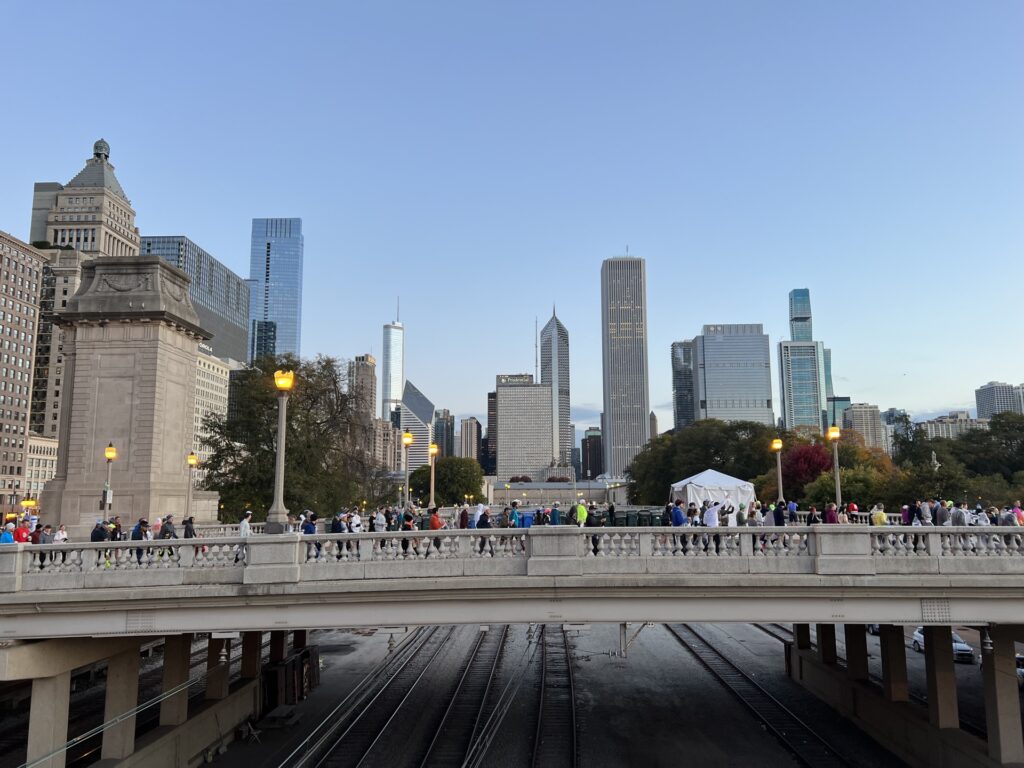
Chicago Marathon History
The Chicago Marathon was first run in 1905. The race began in Evanston with about a dozen runners and ended at the Washington Park Race Track where only seven people crossed the finish line. Long distance running wasn’t nearly as popular back then. Maybe because they weren’t running in the comforts of the latest Nike Flyknit sneakers or because they were taking shots of whiskey for fuel. We’ll never know.
The Chicago Marathon was run annually through the 1920s and continued to gain popularity and prestige. Unfortunately, the global and economic events of the 1920s brought the race to a. It wasn’t until 1977 that the Chicago Marathon became the annual race we know today.
The Chicago Marathon quickly became one of the most important and prestigious races in the world. In 2006, it was named one of the World Marathon Majors, sealing its reputation as one of the most premier races in the world.

The marathon received varying levels of support from the city and sponsors along the way. Sponsorships are important for many reasons, but Chicago needed them to help fund the prize money to attract the elite athletes. They saw a few sponsors come and go before LaSalle Bank became the main sponsor in 1993. LaSalle bank was acquired by Bank of America in 2007, and the race has since been named the Bank of America Chicago Marathon.
The flat course consistently attracts a premier elite field. Five world records have been set on the Chicago Marathon course, including the current women’s marathon world record which was set by Brigid Kosgei in 2019.
Today, the Chicago Marathon is the second largest marathon in the United States, after the New York City Marathon, and is one of the largest running events in the world.
How far is the Chicago Marathon?
Let’s start with an easy one! The Chicago Marathon course is 26.2 miles or 42.195 kilometers in length.
What’s the Chicago Marathon course like?
The Chicago Marathon course changes a little bit each year, but usually follows the same rough path. It’s a loop course that starts and ends at Grant Park.
The race starts downtown, goes north to Wrigleyville, comes back to the Loop around the half, cuts west toward the United Center, then heads south and east to roughly 35th Street before finally heading north on Michigan, up the hill at Roosevelt and finishing back in Grant park.
Here’s the course map for 2023.
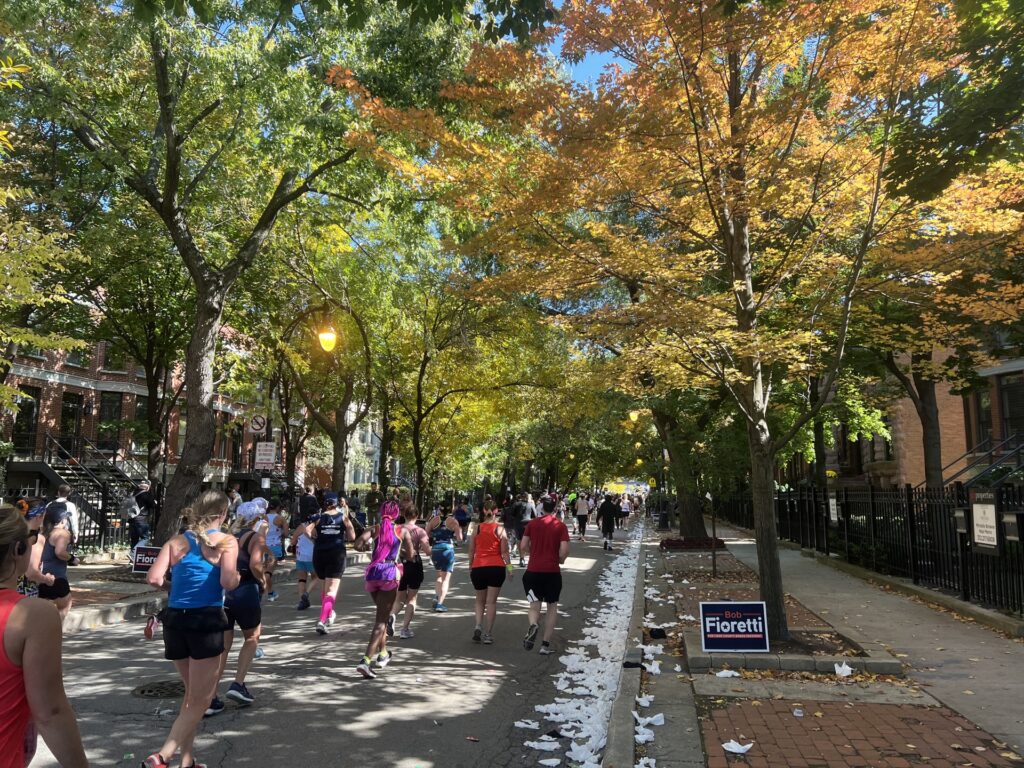
The course is nearly entirely on paved roads, the only exception being a few short bridges with metal grates. In these instances, the grates are covered with a thin carpet material that makes it more comfortable to run over.
The course is also almost completely flat. There is one notable hill (on Roosevelt near the finish line) and a few small inclines (mostly just at the handful of bridges and overpasses), but otherwise the course is very flat. The total elevation change over the course is less than 250 feet.
There are 20 aid stations along the course, each offering water and Gatorade Endurance (lemon lime). Medical support, toilettes and runner transport back to Grant Park are also available at each aid station. A few aid stations later in the course have additional offerings like Biofreeze, bananas and Gatorade Endurance Energy Gels (with caffeine and without).
What is the Chicago Marathon energy like?
The Chicago Marathon course is fun. If you’ve never participated in a big city running event, I think you’re really in for a treat. If you’ve run any of the World Marathon Majors, I would say you can expect similar energy levels and spectators. I’ve run four others (Berlin, Tokyo, London and Chicago), and I would say all had great specators. What sets Chicago apart though is that the energy changes as you weave through each unique neighborhood.
It’s estimated that around 1.7 million spectators line the streets of Chicago to cheer on the runners. At every turn, spectators are holding clever signs, shaking noisemakers and offering words of encouragement. They offer bowls of candy, tissues and even beers to runners as they pass. There’s constantly excited reactions as runners spot their friends and family among the crowds.
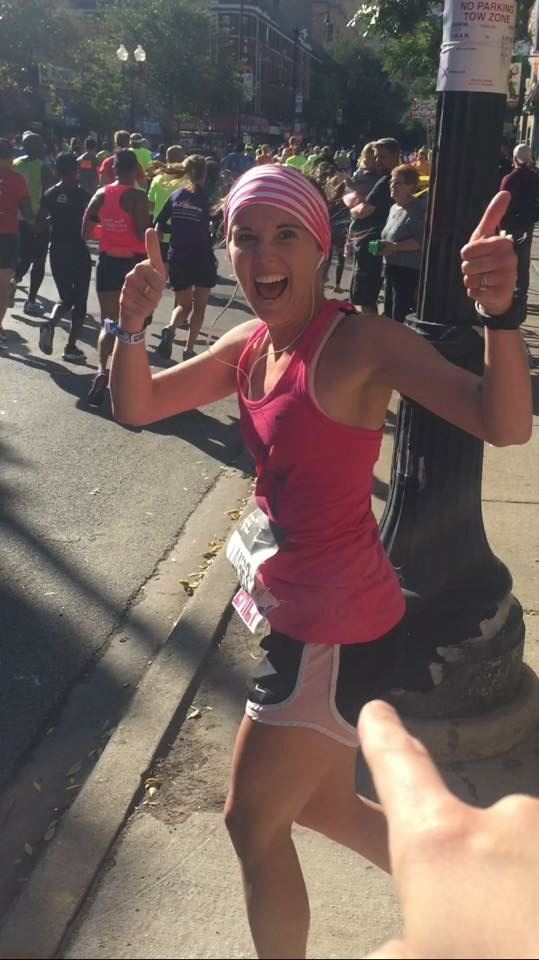
The best crowds are usually consolidated around aid stations, train stops and neighborhood centers. Some of my personal favorite areas to run though are downtown in the Loop, the Moody Bible Institute in Lincoln Park, Boystown, Charity Row on the west side, Chinatown, the one guy who plays Gangnam Style on repeat for the entire race before you get to the highway, and Michigan Ave after mile 25.
The absolute best neighborhood, though, is Pilsen. The spectators throughout this neighborhood are fire. They are non-stop high energy. There is always music blasting, people dancing and playing instruments, and it’s just non-stop cheering for a good mile through the neighborhood. It’s the highlight of my race every year.
Most of the course is pretty well spectated, but the energy is definitely highest during the first half of the race and near the finish. Other than a few hot spots, like Pilsen and Chinatown, I’ve always found the later half of the course to feel a bit light on spectators. This is hard because it’s always when I need it most.
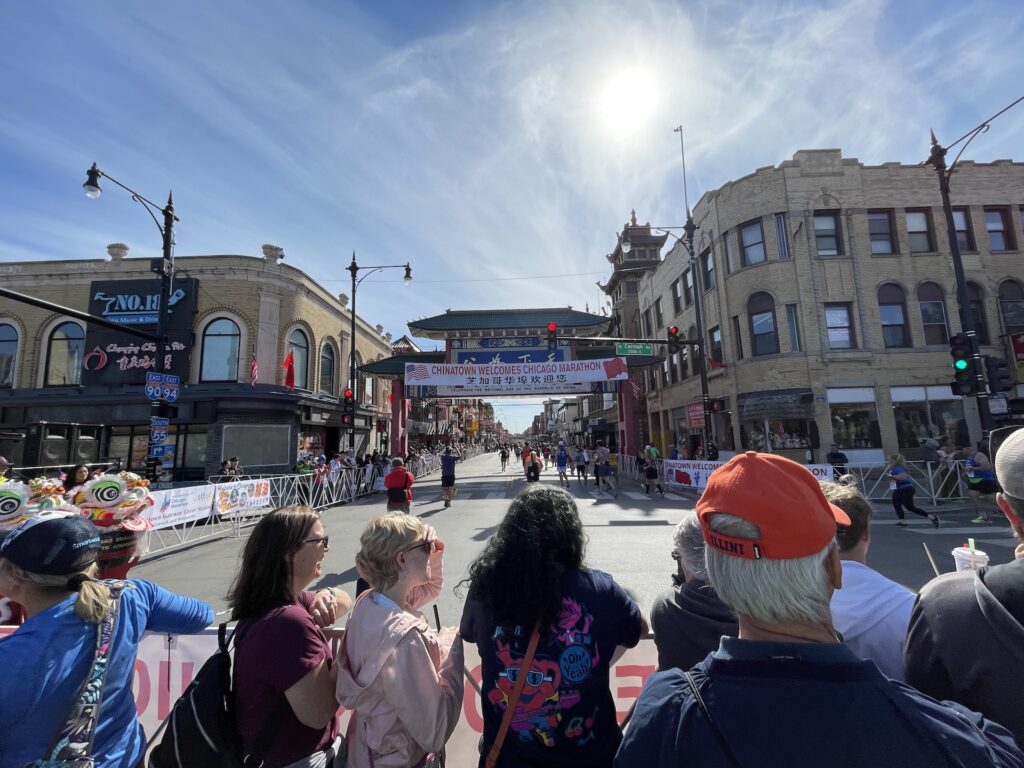
However, the spectators on this portion of the course, particularly between miles 20-24, are the best and most authentic on the entire course. There’s always a handful of people who grab your attention, look you in the eye, and convince you that you can do it. They’re the ones I remember most.
As a slow runner, I usually start pretty late and run well into the afternoon. In some cases, this can mean that fans are heading home, aid stations are starting to consolidate and the energy can sometimes feel like it’s fading. During my first marathon in 2015, I was pretty crushed that there was hardly anyone near the finish by the time I got there. But during my most recent run in 2022 (starting with Wave 3 in Corral K and finishing in just under 6 hours), that was not the case. I felt supported the entire race.
Chicago Marathon Weather
The weather in Chicago in October is usually pretty good for the Chicago Marathon. According to the website Find My Marathon, over the past 17 years the average high for the Chicago Marathon has been 67°F and the average low 51°F.
The weather in 2022 started out with a near-perfect 45°F. It was a sunny day, though, and temps climbed into the 60s by 11 AM.
Staying true to its Midwest charm, weather in Chicago can always be a bit unpredictable. The race has had some hot years, including 2007 which was the hottest on record. The race was cancelled after 3.5 hours when temps hit 88°F. This is not typical for Chicago though and is generally considered an outlier.
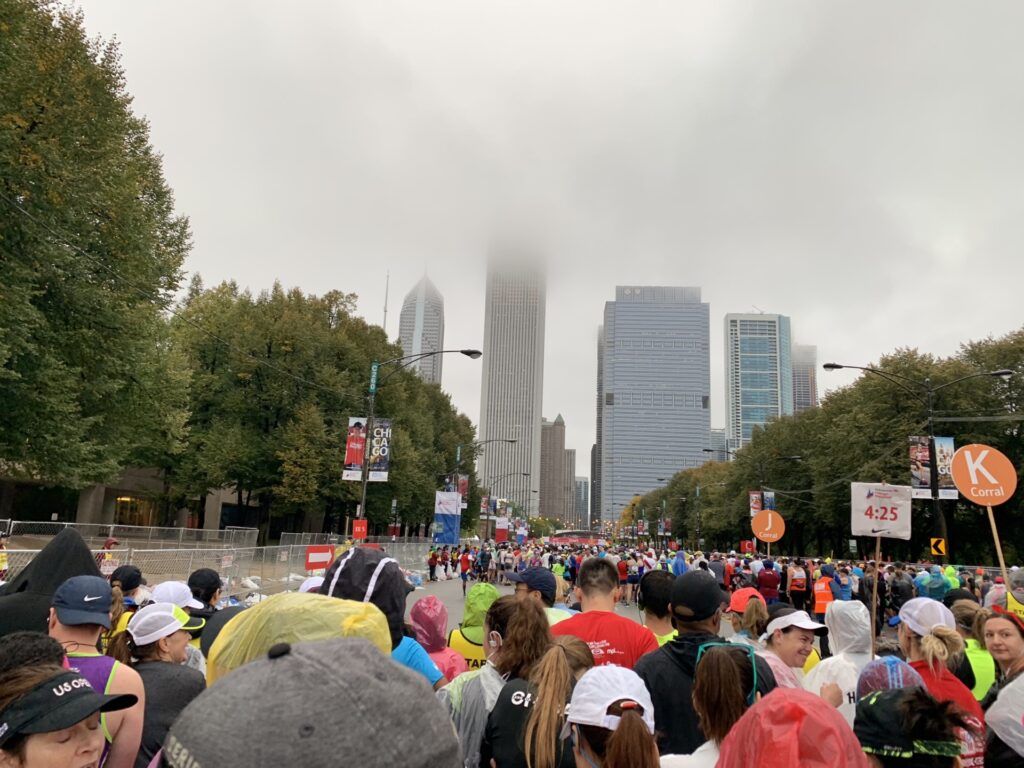
Do you have to qualify for the Chicago Marathon?
The Chicago Marathon is an open race, meaning that there is no specific speed required to enter the race. Runners of all speeds and abilities are able to register and participate in the Chicago Marathon as long as they finish under the course time limit of 6.5 hours.
Runners who take more than 6.5 hours to finish will not be considered official finishers. The course is cleared are roads will reopen at a 15 minute pace from the last runner’s start time. Runners who cannot maintain this pace will be swept from the course. They can either utilize runner transport back to Grant Park or continue to run on sidewalks, but they will not receive on-course support or amenities and will be unable to officially finish.
How many people run the Chicago Marathon?
The Chicago Marathon has seen an average of 39,000 finishers a year over the past 10 years. The race is currently capped at about 45,000 participants. It is the second largest marathon in the US after the New York City Marathon.
The largest Chicago Marathon on record was in 2019 when nearly 46,000 runners finished the race. The marathon was cancelled in 2020 for the COVID 19 pandemic, and when it returned in 2021 with a vaccine requirement there were only 26,000 finishers. In 2022, organizers expected a field of about 40,000 runners.
Elite Field at the Chicago Marathon
Between its World Marathon Major status, the $600,000+ in prize money, and the flat course (have I mentioned that yet?), the Chicago Marathon attracts some of the best runners in the world.
Two new records were set at the 2022 Chicago Marathon. Emily Sisson broke the American women’s marathon record with a time of 2:18:29. She came in second to Ruth Chepngetich from Kenya who was just 14 seconds short of breaking the women’s world marathon record. Marcel Hug from Switzerland won the Men’s wheelchair division and set a new Chicago Marathon wheelchair course record of 1:25:20.
The top five finishers in the mens and women’s field earn between $25,000 and $75,000 dollars. The top ten finishers in the wheelchair division win between $750 and $25,000. There are also bonuses available to runners who break certain course and country records. As of writing this post, there is no prize money or awards for top performers in the new non-binary category.
You can find the 2022 Chicago Marathon top finishers here.
How to Register for the Chicago Marathon
The Chicago Marathon is an open race, meaning that you don’t need a qualifying time to participate. However, the race is capped at 45,000 participants, and the demand is much higher than that. That means that everyone who wants to run the Chicago Marathon cannot simply sign up and do so.
In order to sign up for the Chicago Marathon, you will need to either earn a guaranteed entry slot or luck into a slot via the lottery system. Let’s explore these two different ways to get into the Chicago Marathon.
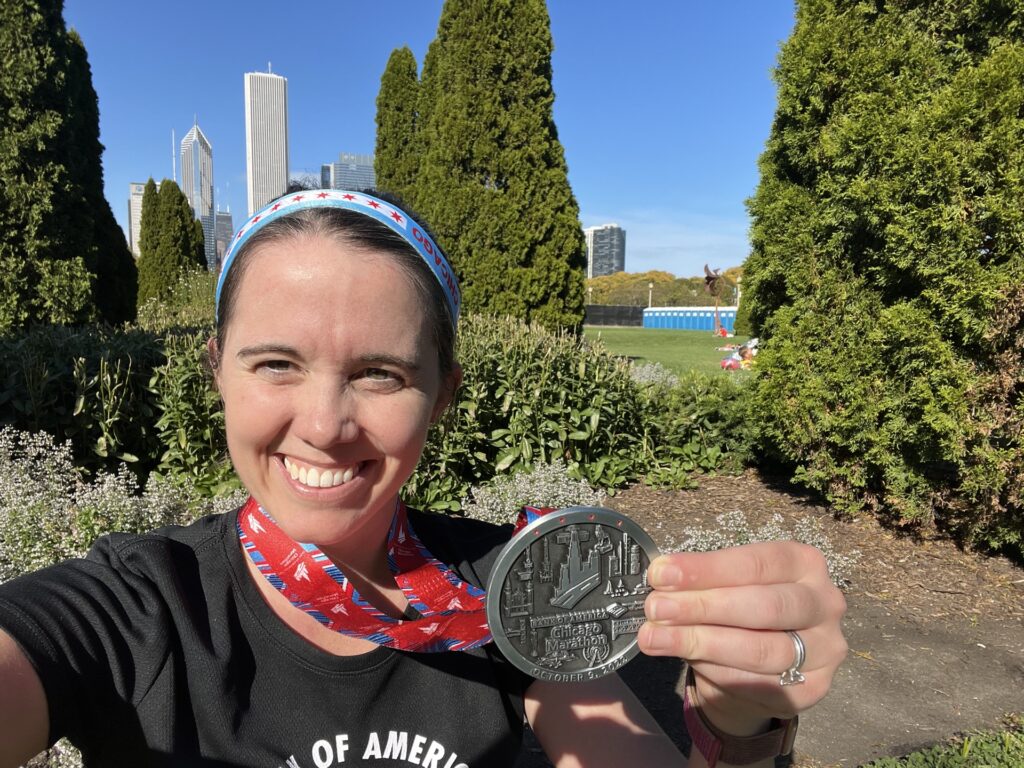
Guaranteed Entry for the Chicago Marathon
There are a few different ways to guarantee entry for the Chicago Marathon. None of them are particularly cheap or easy. Guaranteed entry just means that you have the right to register for the Chicago Marathon. You still need to pay for your registration and meet all rules and requirements associated with your guaranteed entry category.
Here is how you can get guaranteed entry to the Chicago Marathon.
- Time Qualifier or American Development Program: Athletes who can provide a proof of time in qualifying races that meet a strict set of speed requirements by age and gender may earn guaranteed entry.
- Legacy Finisher: Athletes who have finished at least five Chicago Marathons in the past ten years may earn guaranteed entry.
- Shamrock Shuffle Legacy Finisher: Athletes who have finished at least four Bank of America Shamrock Shuffle 8Ks since 2008 and are registered for the 2023 Shamrock Shuffle may earn guaranteed entry.
- Charity Program: Athletes who partner with an approved charity and fulfill their fundraising goal may earn guaranteed entry.
- International Tour Groups: Athletes who purchase a travel package through partner tour providers may earn guaranteed entry.
- Deferred or cancelled entry: In the event of cancellation, either by the athlete or the organization, athletes may be eligible for guaranteed entry for a future race.
If you meet the requirements for guaranteed entry, you can register for the 2023 Chicago Marathon between October 18 and November 17, 2022. You will be required to provide any necessary documentation for your guaranteed entry category. Applications will be reviewed and applicants will be notified of their registration status within 10 days. If for any reason you are not approved, your entry will automatically be added to the lottery for non-guaranteed entry.
If you miss the registration deadline (November 17, 2022), you will not be able to register for the 2023 race even if you meet the guaranteed entry criteria. Once the deadline passes, the only way to enter the race is with the Charity Program or an international travel group.
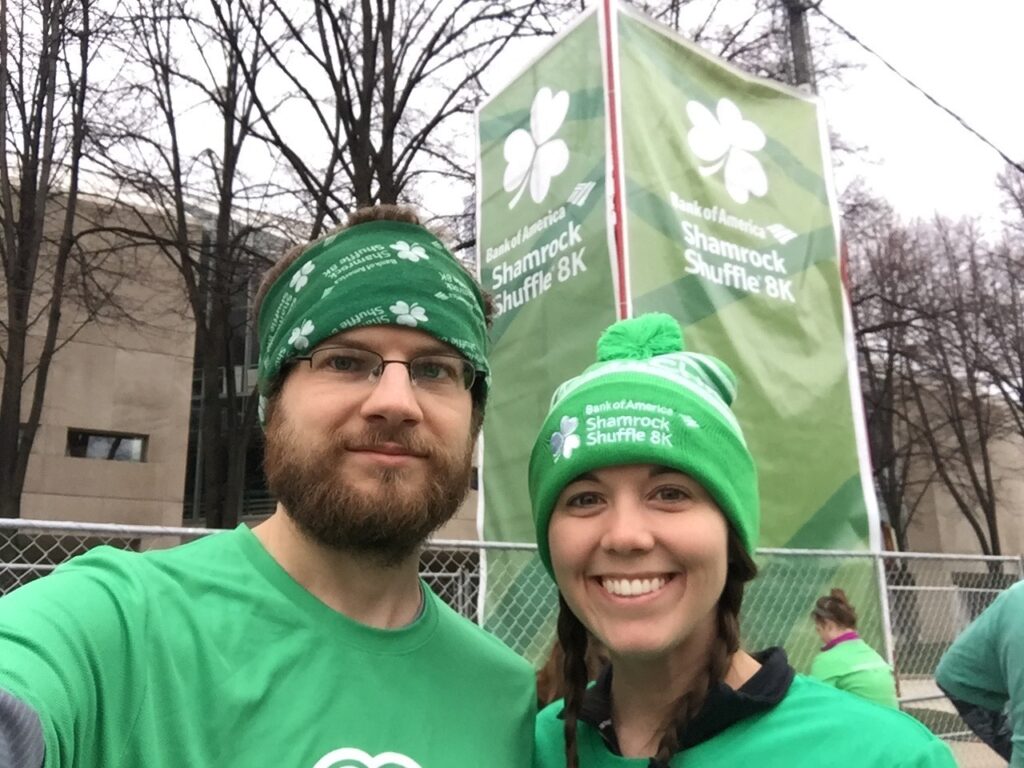
Non-Guaranteed Entry for the Chicago Marathon
If you don’t qualify for guaranteed entry, you can register for the Chicago Marathon lottery. The lottery works like this.
- Interested participants register for the lottery. The lottery for the 2023 Chicago Marathon is open from October 18 to November 17, 2022. Anyone can join the lottery, and there is no proof of time or qualifying time required to registered. Credit card information is required to join the lottery.
- Participants are randomly selected. After the lottery closes, a set number of applications will be randomly selected to participate in the race. Typically, about 60% of the Chicago Marathon field earned their entry via the lottery. That is usually around 25,000 people, but the official count isn’t released in advance.
- Applicants are notified and charged if selected. On December 8, 2022, all applicants will receive an email update with their race status. If you are selected, you will automatically be charged the registration fee and will be officially registered. If you are not selected, you will not be charged anything for trying.
The odds of getting into the Chicago Marathon vary each year. The official numbers aren’t always released, but in 2015, 53% of Chicago Marathon lottery applicants got into the race. That is in alignment with the general assumption that it’s about a 50/50 shot. The Chicago Marathon is usually considered to be the easiest of the six World Marathon Majors to get into via lottery.
Charity Program Entry for the Chicago Marathon
The Chicago Marathon Charity Program is great for a lot of reasons. Not only is it a great way to give back to the community (in Chicago and beyond), but it’s also just an amazing experience. Running for a cause can help motivate you during your training and inspire you on race day. It’s also the only way to guarantee entry after registration has closed.
The Chicago Marathon Charity Program works like this.
First, sign up for a charity team. You can view the full list of partner charities here. Different teams offer different perks, benefits and fundraising goals. When picking your charity team, be sure to select a charity that includes guaranteed marathon entry. (Not all do!) Most charities that include guaranteed entry will cover the registration cost as well if you meet your fundraising goals, but not all. Read all the details about the charity team before you register.
Next, fundraise for your charity. Each charity team has different fundraising goals. At minimum, charity runners will need to raise $1,250 USD if they join before the lottery closes (November 17) and $1,750 USD if they join after. Some teams may have goals higher than that, or different perks for exceeding different goals.
Typically you’ll be provided a fundraising page through a platform like Crowdrise where people can make online donations. All funds raised through your page will be counted toward your goal and will be automatically routed to your charity. If you don’t meet your fundraising goal, you are usually charged the difference to your credit card.
Last, you run the marathon. As long as you hit your fundraising goal and meet any other requirements as set forth by the charity team, you will be eligible to run the Chicago Marathon. Many charity teams offer race day perks like private bathrooms, complimentary food and drinks, shirts for your supporters and more.
The Chicago Marathon Charity Program began in 2002 and has since raised over $200 million for charity partners. In 2019 alone, runners raised a record $27.1 million dollars for charity.
I’ve personally run on a charity team once (for Girls on the Run Solemates) and my husband twice (for Big Brothers Big Sisters). It really is something special. You are running for something bigger than yourself, and that’s an incredible feeling.
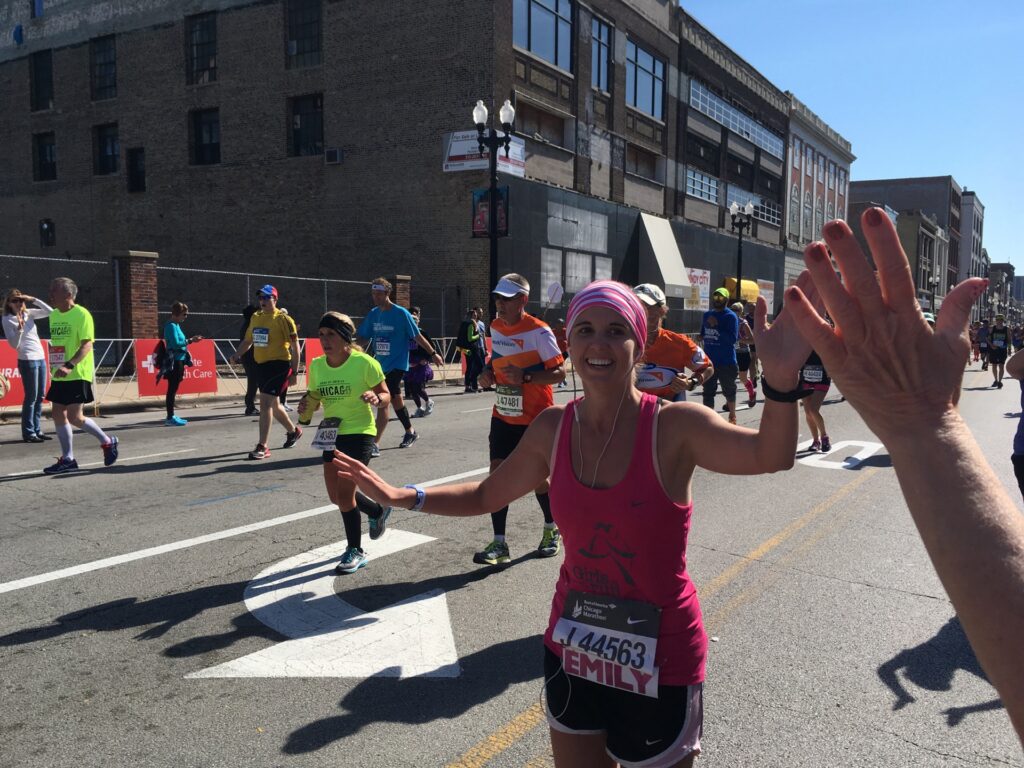
Running for the Girls on the Run Solemates charity team in 2016
When can you register for the Chicago Marathon?
Registration for the 2023 Chicago Marathon will be open from October 18 to November 17, 2022. Applicants for guaranteed entry will be notified within 10 days and non-guaranteed entry applicants (lottery) will be notified on December 8, 2022.
If you miss the deadline for registration, the only way to get into the Chicago Marathon is through the Charity Program or with an international tour group, as long as slots are available.
How much does it cost to run the Chicago Marathon?
The Chicago Marathon costs $230 USD for US residents and $240 for non-residents.
There are two ways to get the registration fee waved.
- Be really fast. Elite athletes who have a verified half or marathon time below the Chicago Marathon’s “high performance standards” are eligible for complimentary entry. The bar here is high and requires a verified sub 2:23:00 marathon time for men and sub 2:43:00 marathon time for women and non-binary athletes.
- Run for (the right) charity. The Chicago Marathon partners with a variety of local and global charities to raise money for important causes. Many, though not all, of these charities will cover the registration fee if you meet the required fundraising goal.
How old do you have to be to register for the Chicago Marathon?
You have to be at least 16 years on race day to run the Chicago Marathon. Runners under age 18 will need to have a parent or guardian approve during the registration process.
Chicago Marathon Race Weekend Logistics
The next Chicago Marathon will be held on Sunday, October 8, 2023 in Chicago, Illinois, USA. Marathon weekend is an exciting time in the city, but with street closures and a massive influx of tourists, it can also be a bit chaotic. In this section, we’ll explore some important details about race weekend. The goal here is to make you feel comfortable about what to expect.
How long should you stay in Chicago for the marathon?
If you’re coming from out of town, you might be wondering how long you need to plan to be in Chicago for marathon weekend. There are a lot of factors involved, but here are a few recommendations based on some common factors.
- Stay in Chicago for 2 days (Saturday through Sunday) if you’re local to the Midwest, have been to Chicago before and this is not your first marathon.
- Stay in Chicago for 3 days (Saturday through Monday) if you are local to the Midwest, but want to have a more relaxing stay and enjoy some of the city, too.
- Stay in Chicago for 4 days (Friday through Monday) if you are traveling domestic by air. With flight delays so common, you don’t want to risk missing the expo (and therefore the race). Be sure to have at least one buffer day between your arrival and race day.
- Stay in Chicago for 5-7 days (Wednesday/Thursday – Monday/Tuesday) if you are traveling internationally. Chicago is a fantastic city, so spend two days on race things and then a few more exploring the city. Depending on nerves and fitness level, you may prefer to do that before or after the race.
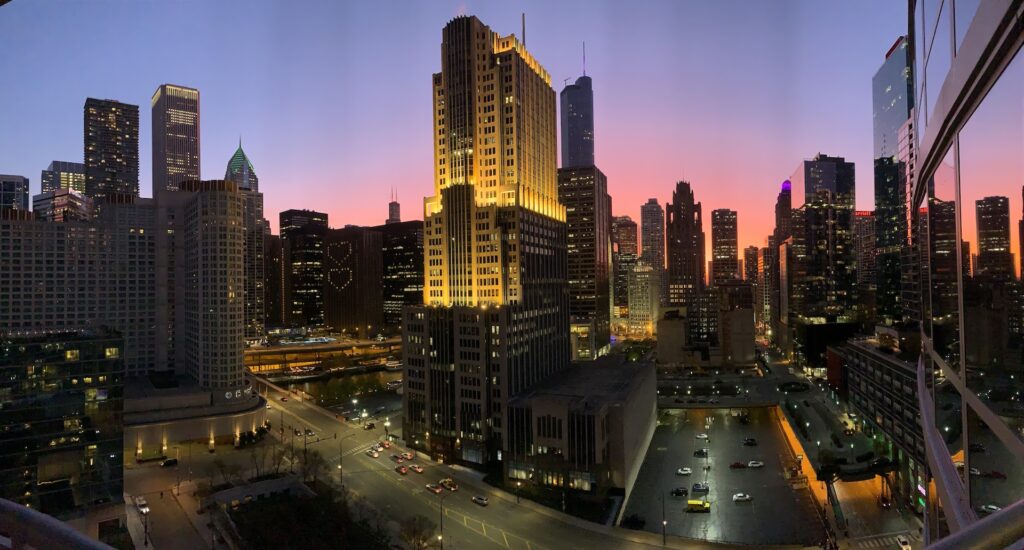
Where to stay for the Chicago Marathon
Marathon weekend is a popular (read: expensive) time to stay downtown Chicago. Hotels often book up well in advance and prices are through the roof.
The race starts and ends downtown, but you don’t have to stay downtown. In fact, it might even be faster to get to the race from a hotel a bit outside of downtown. The most important thing to consider when choosing a hotel for the Chicago Marathon is access to a CTA train. You want to stay close to a train that connects to the Loop — probably the Red or Blue Line.
Here are a few neighborhoods and hotels I would recommend for the Chicago Marathon.
- The Loop: If you want to be as close as possible to the start and finish lines, stay in the Loop. Ideally on Michigan Ave. The Congress Plaza Hotel, The Blackstone (Marriott) and the Chicago Athletic Association (Hyatt) are all nice options.
- River North / Streeterville: Just north of the Loop, there are tons of hotels (as well as restaurants, bars and shopping). You can easily walk to the start from here, but it will probably take around 20-30 minutes. You can also take the Red Line one or two stops. Consider Loews Chicago Hotel, Hampton Inn Downtown/Magnificent Mile or SpringHill Suites Downtown/River North.
- Chinatown: This neighborhood just south of the Loop is actually perfect for the Chicago Marathon. The start is just 2-3 stops away on the Red Line (depending on your wave), so you can get there in about 15 minutes. Plus, it’s only about a mile walk from the Expo, which can otherwise be a pain to get to. There aren’t a ton of options, but the SpringHill Suites Chinatown was absolutely perfect for my most recent Chicago Marathon.
- Wicker Park: If you’re planning to stay a while and are interested in a neighborhood with some character, consider this trendy neighborhood northwest of the Loop. The Damen and Division Blue Line stops will get you downtown for the start in about 25 minutes. Again, there aren’t a ton of hotel options, but Hyatt Place Wicker Park and The Robey are good picks.
- Wrigleyville: While there aren’t a ton of hotels in Wrigleyville, Hotel Zachary is a good option for a unique Chicago experience. It’s only a few blocks from the Red Line which will get you to the starting line in about 30 minutes.

Personal Recommendation
Personally, I’d recommend the Lowes in Streeterville or SpringHill Suites Chinatown.
I used to live right next door to the Loews and have walked to Grant Park from there plenty of times. It’s a nice walk, but it takes longer than you think to get to the starting line. Plan for about 30 minutes.
I ended up at the SpringHill Suites Chinatown for the 2022 marathon. I had booked a different downtown Marriott, but they were oversold and had to send me to Chinatown. At the time I was livid, but it was really a blessing in disguise. I got from my room to the race entrance in 20 minutes flat (and that included an 8 minute wait for the train, which is about as long as you can get).
Chicago Marathon Expo
The Abbott Health & Fitness Expo takes place every year the Thursday, Friday and Saturday before the marathon on Sunday. It includes packet pick-up, official race merchandise and a variety of health and fitness vendors. There is entertainment and speakers, tons of photo ops and a handful of food and beverage options. There’s usually a station to make banners, lots of free samples and other tchotchkes and prizes.
The Expo is free and open to the public. All runners are required to visit the Expo to pick up their race packet and t-shirt. There is no packet picket available on race day.
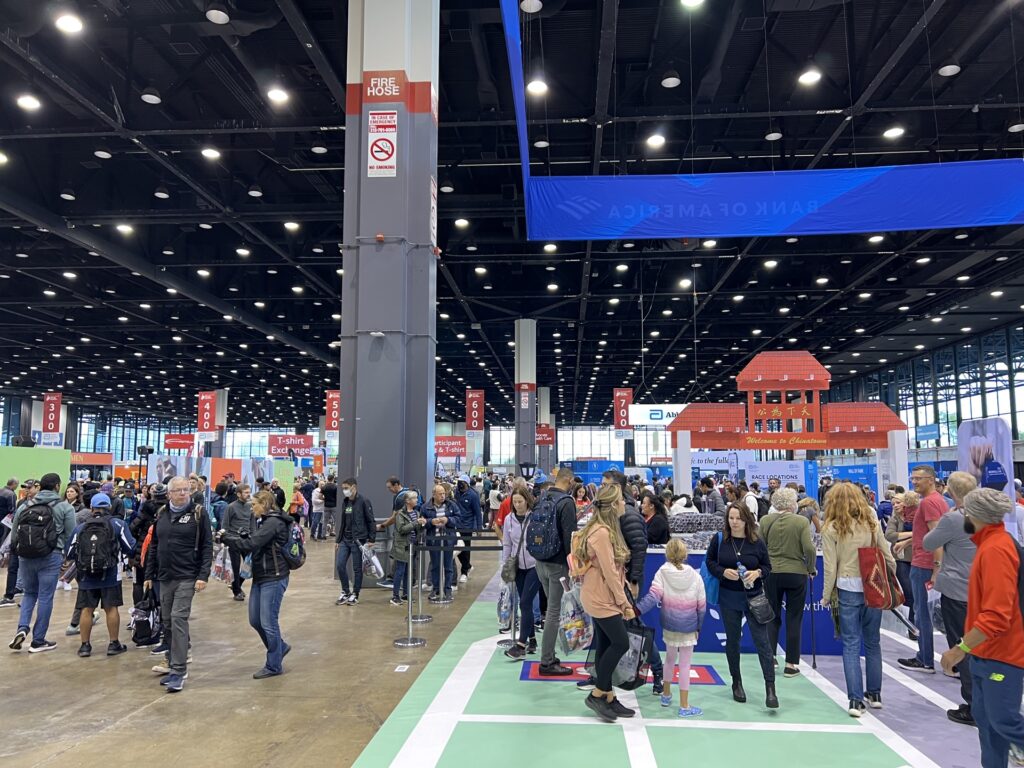
The Expo always takes place at McCormick Place, but the specific room location in the massive convention center varies by year. Be sure to check the address listed on the official website for the exact location. There will also be signs and lots of people around to get you where you need to go.
The Chicago Marathon Expo can end up filling up an entire day. The commute can easily take an hour in each direction, and then you’ll need at least an hour to navigate the massive complex to packet pick-up, go through security and get your bib. If you want to visit the vendors, do some shopping and watch any of the speakers, it’ll be at least another hour.
I would recommend allotting at least four hours for the Chicago Marathon Expo. You can of course get through faster than that, but plan for the worst.
How to get to the Chicago Marathon Expo
McCormick place is a bit of a hike from downtown. The Chicago Marathon organizers used to offer a shuttle from downtown to the Expo, but they stopped offering that service in 2019. But don’t worry, there are plenty of easy ways to get to McCormick Place from downtown.
- CTA Train: Take the Green Line train to Cermak-McCormick Place and walk 0.5 mile or the Red Line train to Cermak-Chinatown and walk 0.8 miles.
- CTA Bus: Take the 3 or 21 bus to McCormick Place, right outside the main entrance.
- Metra Train: Take the ME (Metra Electric) line to McCormick Place station, which exits into McCormick Place itself.
- Car: If you choose to drive, the closest place to park is Lot A. There is also a single pick-up point near the main entrance for taxis and rideshare drivers.
- Walk: Depending on where you’re starting from, you may be able to walk. It’s about 1.6 miles from the south end of Grant Park and accessible via Michigan Ave. McCormick place is also adjacent to the Lakefront Trail, but I’ve tried to walk to the Expo from the trail before and it’s not an easy entrance.

Chicago Marathon Packet Pick-up
Packet pick-up for the Chicago Marathon is at the Abbott Health & Fitness Expo. The actual process is a bit different than many other races and often causes some confusion, especially for first-time runners. Here’s how it works.
- First, you’ll go to a booth where someone will scan your registration code (which you will receive via email prior to the event) and verify your ID.
- Then, you will be assigned a number that corresponds with a booth in the next area. At that booth, you will receive your race packet, which includes your bib.
- Lastly, you will need to take that race packet to the t-shirt distribution booths to receive your shirt.
Despite being a multi step process, packet pick-up is generally pretty smooth.
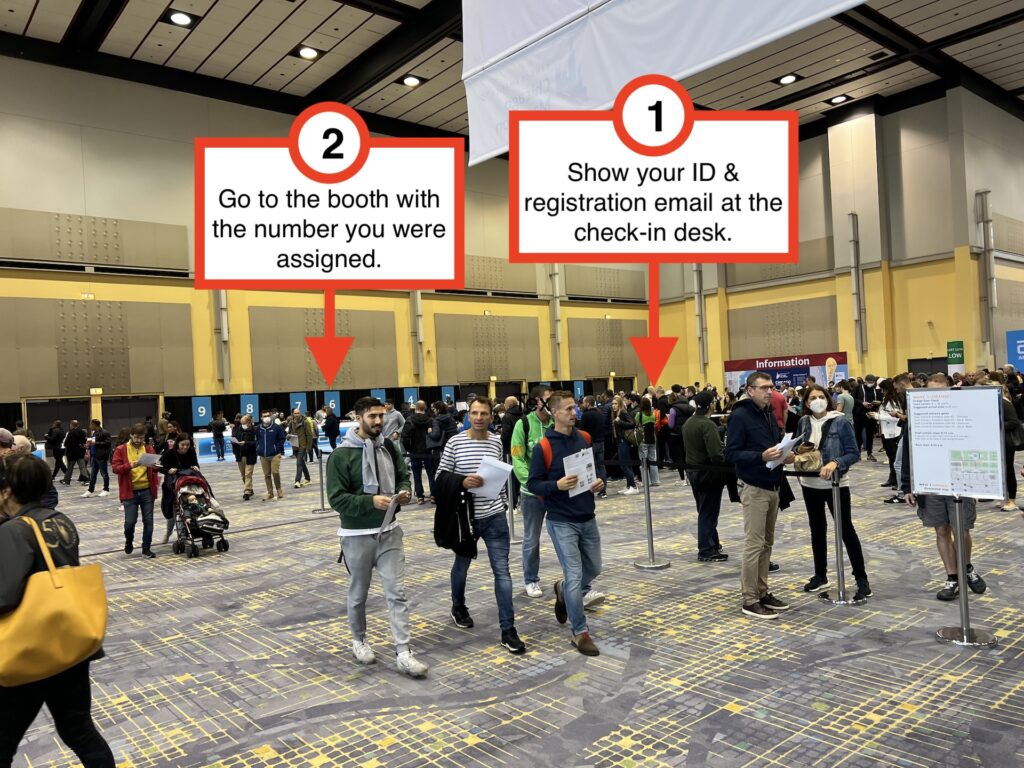
Chicago Marathon Apparel
Nike is the official sponsor of Chicago Marathon apparel. The race t-shirts, which are included with registration, are made by Nike. They also create a line-up of Chicago Marathon clothing items including running shirts, outwear and bottoms, which are available for purchase. Some years, the merch is incredible, other years it’s just so-so.
Nike Chicago Marathon merchandise is available at the Chicago Marathon Expo, the Nike store on Michigan Avenue, and select Fleet Feet locations around the city. (In 2021, Nike race apparel was not sold at the Expo but it returned in 2022.)
There is also a line of finisher apparel which is only released at the Nike store on Michigan Ave. Finisher gear is not usually released until the Saturday before the race. In 2022, finisher gear was available in stores on Friday, one day before it was officially scheduled to be available. I think this was because other shipments didn’t arrive and they wanted to sell what they had, but it’s worth checking early in the future if you’re in the area.
Chicago Marathon gear is also sold online on the Nike website. It is usually available a few weeks prior to the race and is available until it sells out. After the race, if there is any remaining finisher apparel available, that will be listed online as well. Sometimes you can even get discounted merchandise if you wait long enough, but you can never count on that.
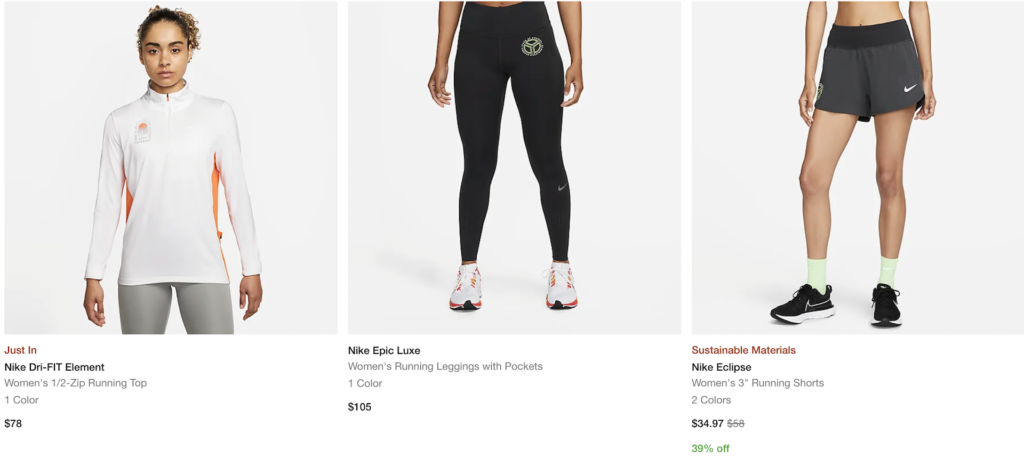
Corrals and Waves at the Chicago Marathon
Corrals and waves are used at the Chicago Marathon to organize runners for the start. Your corral and wave will determine the entrance you should use, your gear check area, and when you start the race. There are 14 corrals (lettered A through N), and each of those corrals is grouped into one of three waves.
Each runner is assigned a corral based on how fast they expect to run the marathon. Runners who expect to be placed in Wave 2 or 3 (corrals F – N) do not need to submit a proof of time. The cutoffs for each corral will vary by year, but in 2022, this would include all estimated finish times over 3:40:00.
Runners who expect to run faster than that and wish to be placed in Wave 1 corrals (A – E) will need to submit a verified proof of time. That means that they must have run a qualified half marathon or marathon at that pace in the past two years (for example, for the 2022 Chicago Marathon, verified times after January 1, 2020 were accepted).
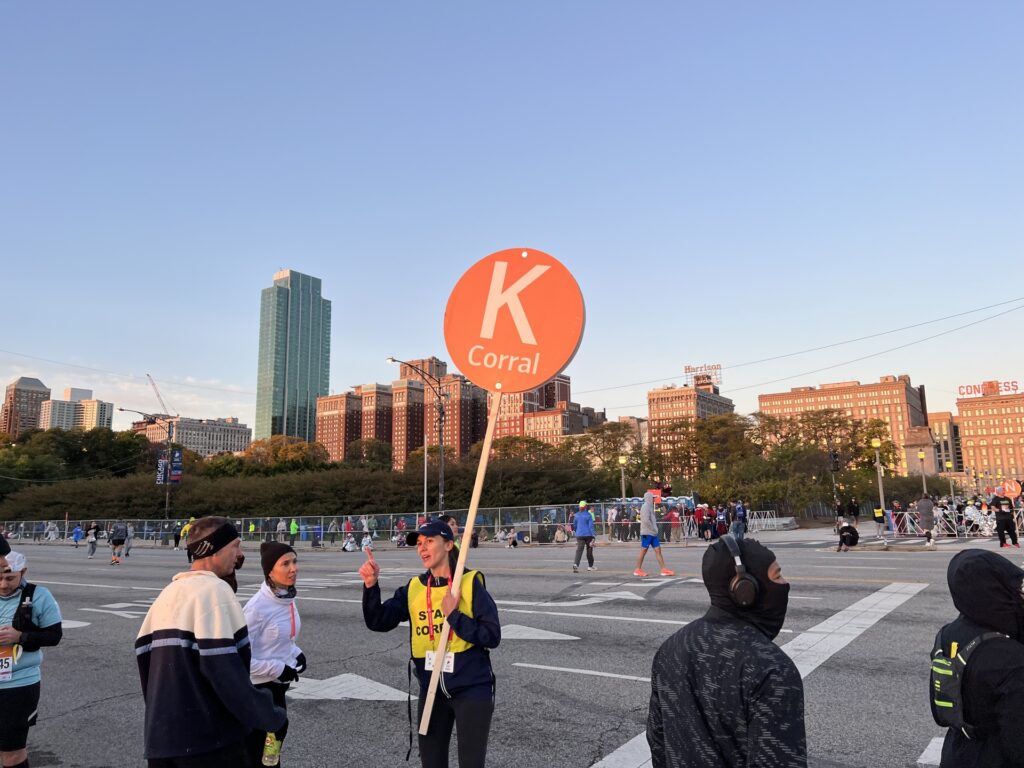
The first corral assignments are released in early August based on submitted estimated finish times. There is a short window, typically 24 hours, when you can request a corral change. If you expect to run faster than you originally thought or if you feel like they made a mistake, you can submit a change request. It will be reviewed and if it’s approved, your corral may be changed.
Corral assignments are not guaranteed and are assigned on a first come, first served basis. That means that even if you qualify for a faster corral, if you submit your time late or register late, you might still get put in a later corral. Personally, I’ve had success changing my corrals with no problem, but I’ve always been in Wave 2 or 3 corrals.
After the corral change deadline passes, there is no way to change your corral. Your corral is clearly visible on your bib and there are officials at all corral entrances checking bibs. If your corral closes before you get there, you will have to start at the back of your wave. If you miss your wave start, you’ll have to start at the back of the following wave.
The official rule is that you can only run in your designated corral. However, you are usually able to fall back a corral to run with someone else. For example, my husband usually qualifies for Wave 1, but I’m usually in Wave 3. He has always been allowed to fall back and run with me, but I would not be able to jump up to run with him.
What time does the Chicago Marathon start and end?
Be sure to check the official Chicago Marathon website for exact times for the 2023 marathon. This section is meant to be a general guide.
The Chicago Marathon usually begins at 7:20 AM with wheelchair athletes and then the elite field at 7:30 AM. There are then rolling starts by corral roughly every 10 minutes until about 9 AM.
The Chicago Marathon course time limit is 6 hours and 30 minutes, which is a 15 minute per mile pace. The course is cleared and roads will reopen on a rolling basis from the last start. The final runners are crossing the finish line around 3:30 and all roads are generally back open by 4 PM.
The Chicago Marathon post-race party also ends at 4 PM.
How early do you need to get to the Chicago Marathon?
You will need to get to Grant Park well before your scheduled wave start time.
The first hurdle is security check. There is a security check point at every entrance, and those lines can be long. If you don’t have a gear check bag or a filled running belt though, you can skip this line.
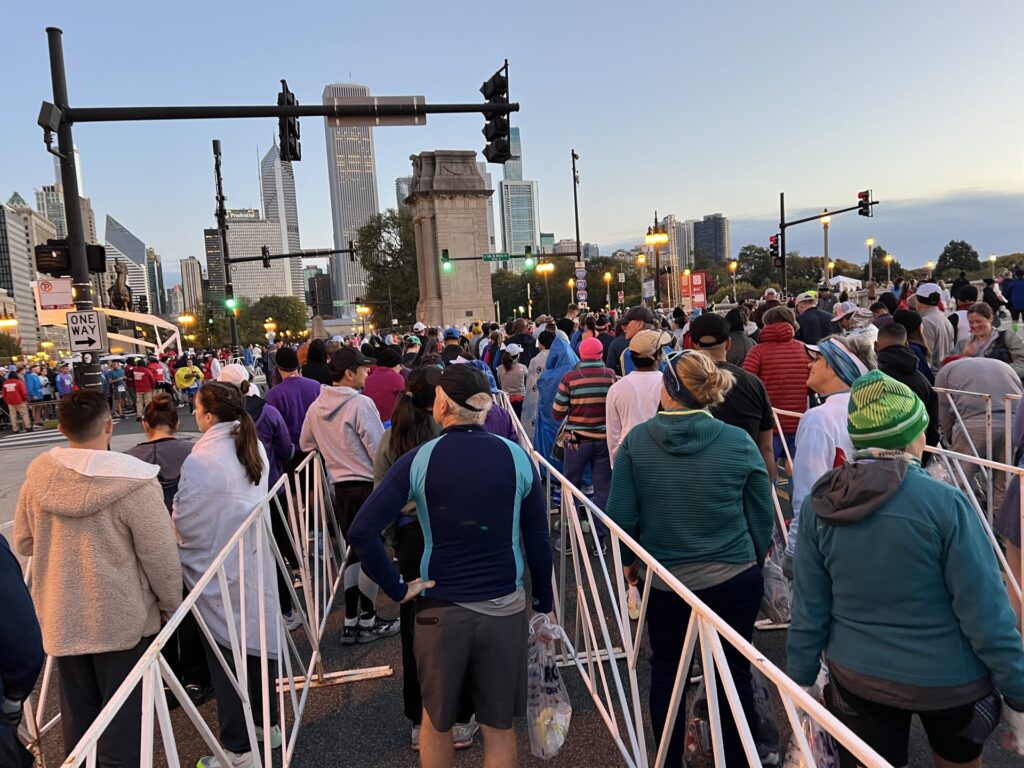
Then there’s gear check. If you have to check a bag, you will need to navigate to the gear check area for your wave. This may involve a bit of walking between the entrance, to gear check, and then to your corral. There may also be lines at gear check.
If you have to go to the bathroom, that will be another line. There’s tons of toilettes, but also tons of runners and there are always long lines, especially the closer you get to race start time.
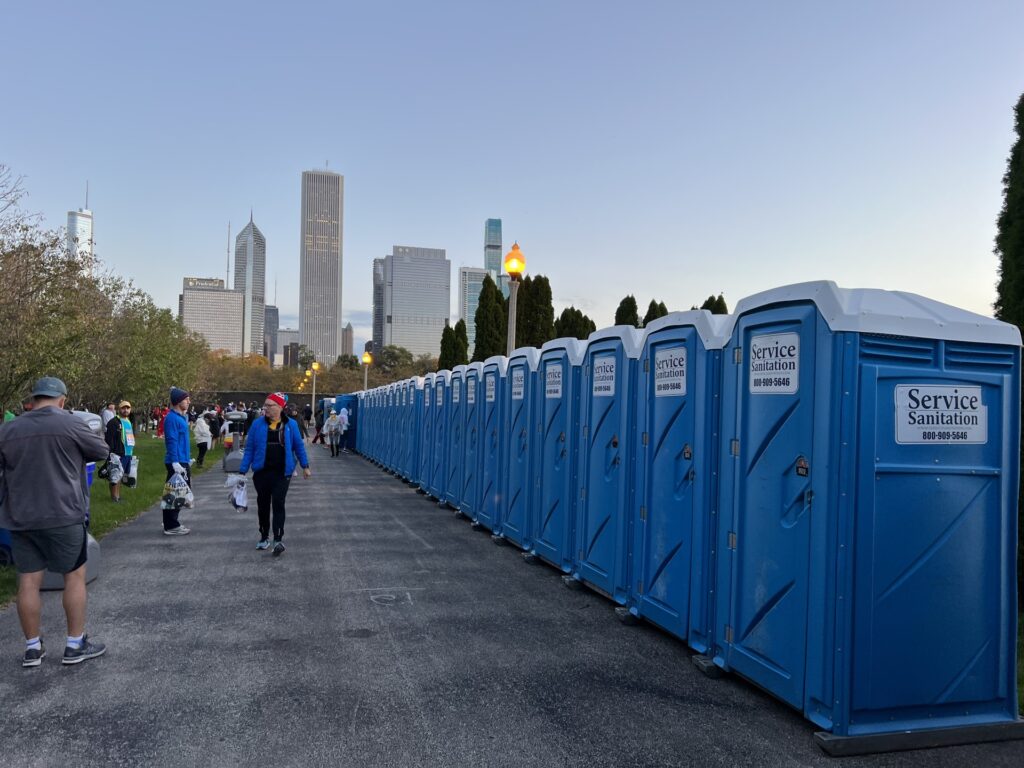
Finally, the corrals for each wave close 15 minutes before the start of that wave. If your corral closes, you will have to start at the back of that wave.
The official participant guide has a recommended arrival time for each wave, which is usually 2 hours prior to the wave’s schedule start.If you want to play it safe, of course follow the official suggestions. But if you’re looking for a personal recommendation, I’d say that’s a bit aggressive. Personally, if you aren’t gear-checking and you have no bags, arriving 30 minutes before your corral closes should (usually!) be just fine.
Getting to the Chicago Marathon Start
If you take away one thing from this post, please let it be this: take public transportation (or walk) to the starting area. Between road closures, traffic and a high volume of people trying to get to the same place, do not attempt to drive or take any kind of car service.
The easiest way to get to the Chicago Marathon starting area is by train, because they are not impacted by street closures. Nearly all CTA train lines stop just blocks away from the entrance on Michigan Ave.
Here are the stops that are closest to the Chicago Marathon start for each CTA train line.
- Blue Line: Jackson
- Red Line: Jackson (Wave 1) or Harrison (Wave 2 or 3)
- Brown, Orange, Pink & Purple Lines: Harold Washington Library (State and Van Buren)
- Green Line: Adams and Wabash
Gear Check at the Chicago Marathon
The Chicago Marathon offers gear check, and it’s really easy and efficient.
When you pick up your shirt at the Expo, you will receive a clear plastic draw-string bag. This is your gear check bag. No other bags will be accepted. Attached to each bib is a gear check tag and claim ticket, each which have your bib number on it.
To check your gear on race day, put all your things in the clear plastic bag. Attach the gear check tag to the bag by looping it through the strings. Follow the signs to the gear check area for your wave, and then find the booth number that corresponds to your bib number.
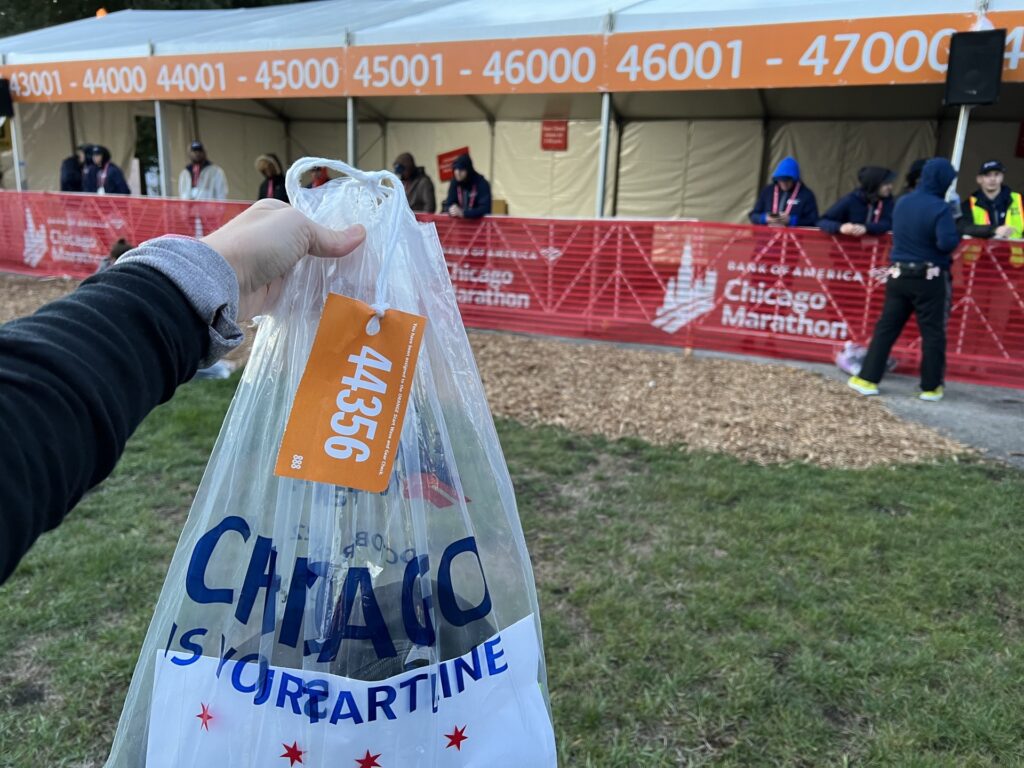
The Chicago Marathon course is a loop, so you’ll pick your bag up after the race at the same place that you dropped it off. Simply show them your claim ticket (or your bib) and they’ll retrieve your bag for you.
I’ve always avoided gear check because I never wanted to waste time on it. However, I did it this year and it was a breeze! If you have things you want to bring, there’s no reason not to gear check. It’s really well staffed and really quick.
Another thing to note here is that the Chicago Marathon donates all clothing and attire left in the starting area. If it’s cold, don’t plan to check your outer layers. You’ll have to shed and check them too early. Instead, bundle up in old clothes and ditch them right before you start. You’ll stay warm longer, and your clothes will go to a good cause.
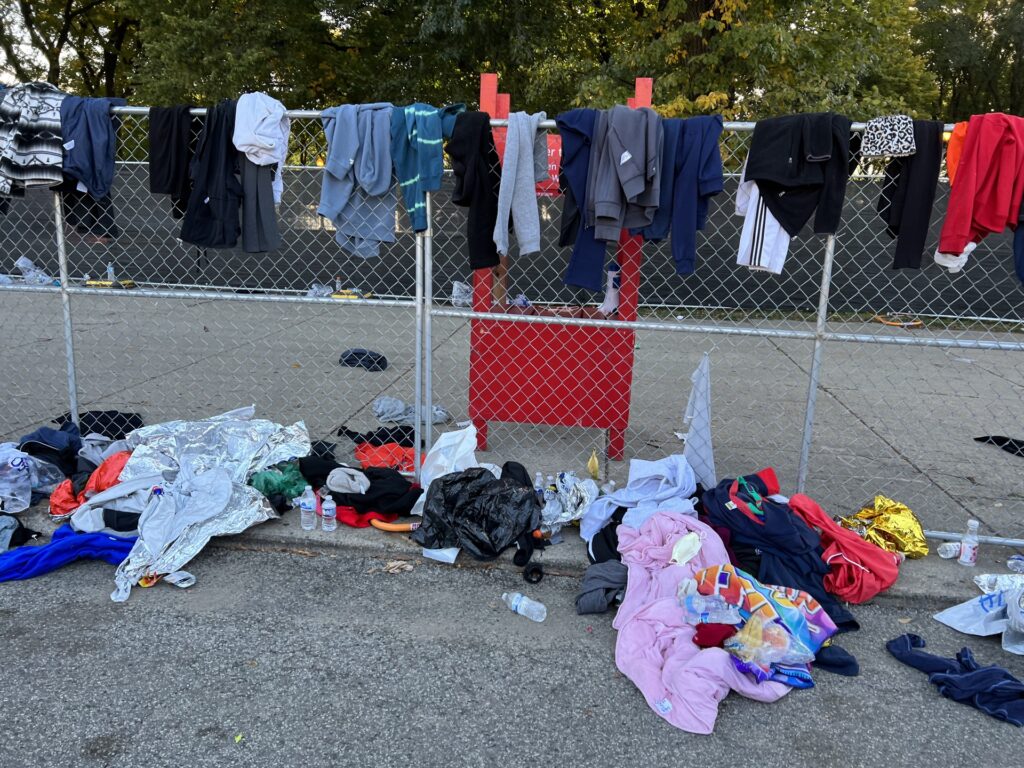
Chicago Marathon Pacer Teams
The Chicago Marathon has pacers available throughout each wave and corral. The Nike Pace Teams are lead by expert runners who run the marathon at a set, consistent speed. Pace teams are available for a wide range of estimated finish times including every 5 minutes from 3:00 – 4:00 hours, every 10 minutes from 4:00 – 5:00 hours and every 15 minutes from 5:00 – 5:45.
It’s free to join a pace team. You can stop by the Nike Pace Team booth at the Expo to receive a bib that indicates you’re a part of that pace team, but you can also just find a pace team in your corral and run with them.
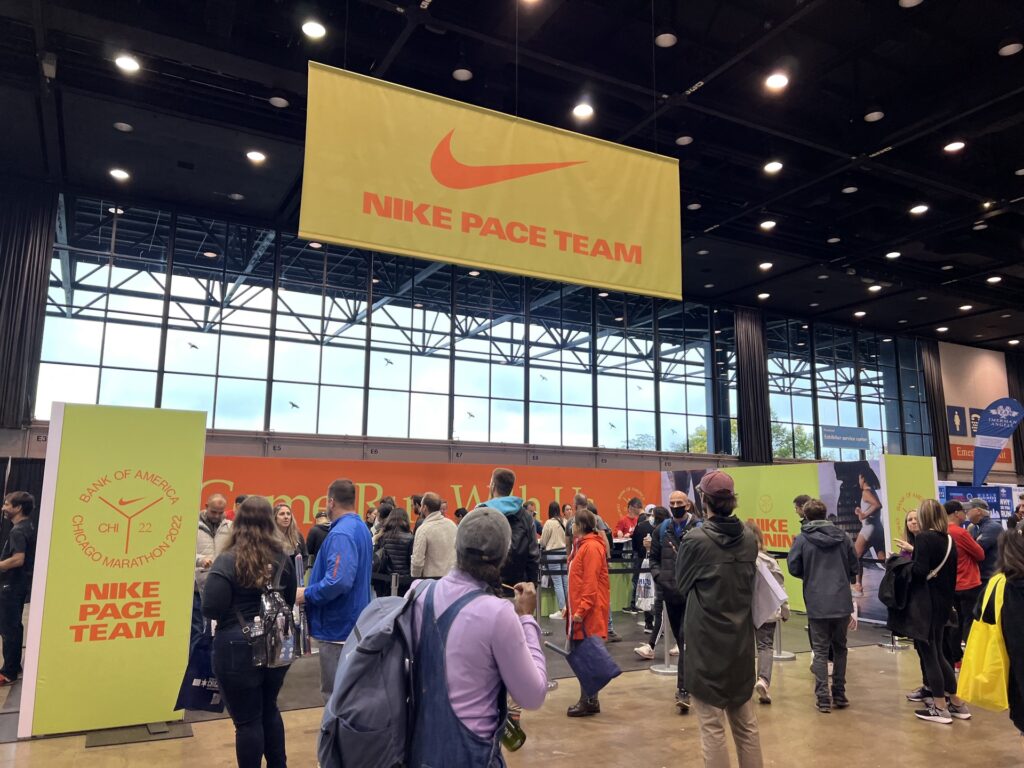
I don’t usually run with pace groups (I’m not that consistent), but I did run the first half with one the year I ran my PR. The Nike Pace Teams for the Chicago Marathon are really good. They’re extremely accurate and many of them are also just really fun to be a part of. They’ll often hype up the crowd, cheer you on along the way, and can really motivate you to perform at your best.
Aid stations & on-course amenities
The Chicago Marathon is an extremely well run race and the aid stations are a prime example of that. There are 20 aid stations on the 26 mile course, each one is incredibly well stocked and manned by a slew of volunteers.
Each aid station has cups of Gatorade Endurance (lemon lime) and water. There are bananas available at four aid stations between miles 15 and 18 and Gatorade Endurance Energy Gels at miles 10 and 14.
Each aid station also has toilettes, medical support and runner transport back to Grant Park available.

Things to do in Chicago while you’re here for the Marathon
Marathon weekend is a great time to be in Chicago! The weather is usually incredible, and you should just catch the start of fall colors if you’re lucky. There’s a ton of things to see and do, but here’s a short list of my favorites.
- Go for a run on the Lakefront Trail. If you need to go for a shake out run, you absolutely must do it on the Lakefront Trail. The stretch between Ohio Street Beach and Fullerton is a stunning 3-mile stretch. If you had to pick one direction, run north to south.
- Take an architecture cruise. There’s no better way to see the city than from the Chicago River. It’s also great because you can see a lot without doing much walking, which is important before or after the marathon. My favorite hack is to ride the water taxi instead, but it’s usually done running for the season by marathon time.
- Eat all the Chicago things. After running a marathon, it’s time to treat yourself. Deep dish pizza from Lou Malnati’s. Thin crust pizza from Giordano’s. Hot dogs from Portillo’s (or one of the better hot dog stands if you can). Italian beef from Buona. Garrett Mix from Garrett Popcorn Shops. Pumpkin Old Fashion donuts from Stan’s Donuts. Tacos from Velvet Taco (Ok fine, not a Chicago thing, but they’re not everywhere and they’re amazing, so get them. You earned it.)
- Stroll along the Riverwalk. Pick up a Pumpkin Spice Latte from the Starbucks on Michigan and Wacker. Cross Wacker, take the stairs down to the Riverwalk and head west. It’s a beautiful walk lined with cafes, bars and outdoor seating space. It’s a great place to sit or walk, reflect and prepare yourself mentally for the challenge ahead.
- Get a good view. Chicago is a beautiful city and there are several places to get an epic view from above. The Hancock Building and Willis Tower (formerly the Sears Tower) both have great observation decks. The Ferris Wheel at Navy Pier is another great option.
- Explore a neighborhood or two. Chicago is a city of neighborhoods. Before or after your race, take some time to explore one or two. Bonus points if you pick one that the course runs through. Find a hot, trendy restaurant in the West Loop. Go to the zoo in Lincoln Park. Get bubble tea in Chinatown. Go to the Museum of Science & Industry in Hyde Park. Or my personal favorite thing to do in the fall … walk up and down the streets in Gold Coast (Dearborn or State between Division and North), admiring the houses, colorful trees and festive halloween decorations.
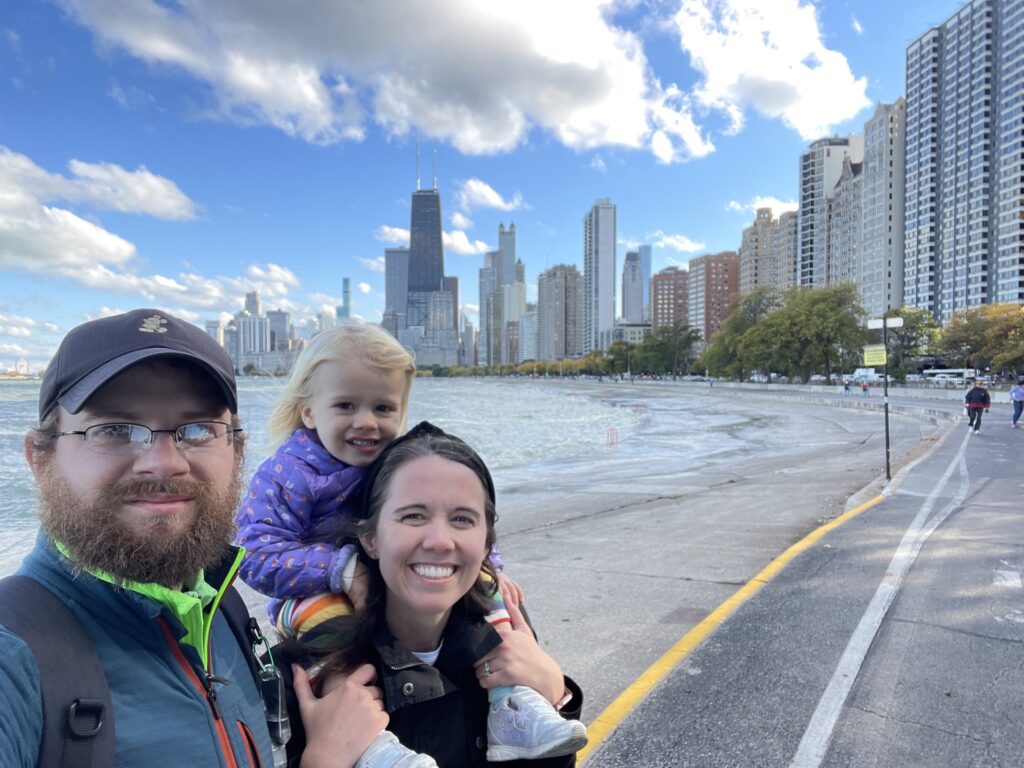
Lakefront Trail view south from North Ave
2022 Chicago Marathon Recap & Race Review
I’ve said a lot about the Chicago Marathon already (6,000+ words to be exact), so I’ll try keep this section a bit brief. I just want to breeze through my experience with the 2022 Chicago Marathon and share a quick summary of my feedback.
My Story
I was really excited about the Chicago Marathon this year. I ran the marathon 4 times between 2015 and 2019. The race was cancelled in 2020, which worked out for me because I had a baby a few months before. In 2021, I did not train at all, aside from an attempted 15 miler which turned out to be a 7 miler. I ran that marathon any way and it was awful in every possible way.
In 2022, I was ready. I trained. Not aggressively, but I ran multiple days a week and worked up to 18 miles as my longest training run. Having moved to New York City the previous spring, I was just excited to get back to Chicago and see my favorite city again.
This year’s race exceeded my expectations and was delightful in every possible way.
Registration
I registered for the Chicago Marathon with guaranteed entry as a legacy athlete. It was a quick and easy process. I had no issues verifying my legacy status and I was quickly approved and charged my registration fee.
Expo
The Expo was my least favorite part of the 2022 Chicago Marathon. This was partly because I had a toddler melting down throughout my visit, but also because it actually was worse than previous years.
We arrived around 10:30 AM on the Friday before the marathon. It was packed and chaotic. It took us +20 minutes to get through the security check, which was very poorly organized. After that though, the Expo itself was fine. Packet pickup was smooth and the participant shirt was great.
I spent most of my time in the Nike booth. It’s a really crowded booth, but they’re very well staffed and always high energy. They keep everything stocked the best they can and the register lines move at lightening speed. Despite “not loving” the merch this year, I still managed to drop $300 on four items, so ya know.
If you’re into headbands, stop by the Sweaty Bands booth. They have tons of colors and patterns to choose from and the quality is amazing. I picked one up from them last year on a whim and love it. They do not slip and do a great job holding back wispy hairs.
I didn’t spend much time at many of the other booths.
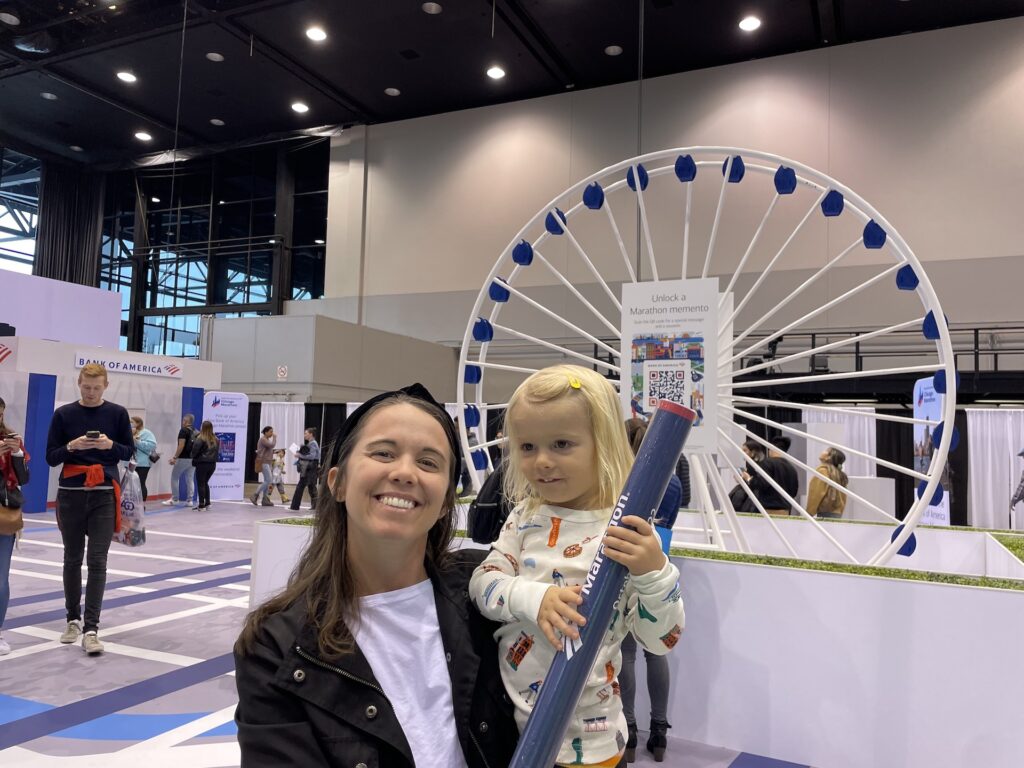
Hotel
I booked a one-night stay at Courtyard Marriott Downtown/Magnificent Mile on September 6 for the night before the marathon because I wanted to walk to the start. They were oversold and did not have room for me when I showed up. They refunded the charged, paid for my Uber to the SpringHill Suites in Chinatown and comped my stay there.
I was mad at the time, but I honestly loved the hotel in Chinatown. Transportation to the start was an easy two stops on the Red Line and I could have walked to the Expo if I’d have been there earlier. I’d choose to stay at the Chinatown location in the future.
Getting to the Start
I took the Red Line from Chinatown to the Harrison stop. I had to wait 8 minutes for the train, which is about the max waiting time. It was just two stops on the train followed by a quick two-block walk.
There are seven entrance gates to the starting area, all on Michigan. Anyone can enter at any gate, but there is a recommended gate for each corral. I was in Wave 3, Corral K, so my suggested entrance was Gate 6 on Harrison Street.
My recommended arrival time was 6:30 AM. I arrived at 6:46, was through security by 6:51.
Gear Check
This was my first time checking gear at the Chicago Marathon. (Up until this year, I always lived a mile or two away so I never had a need to check anything.) I thought it was going to be a bigger deal than it was.
I showed up at gear check at 6:55 AM and there was absolutely no line. The gear check area was on the way to my corral anyway, so the whole thing added maybe a minute to my morning. Easy peasy.
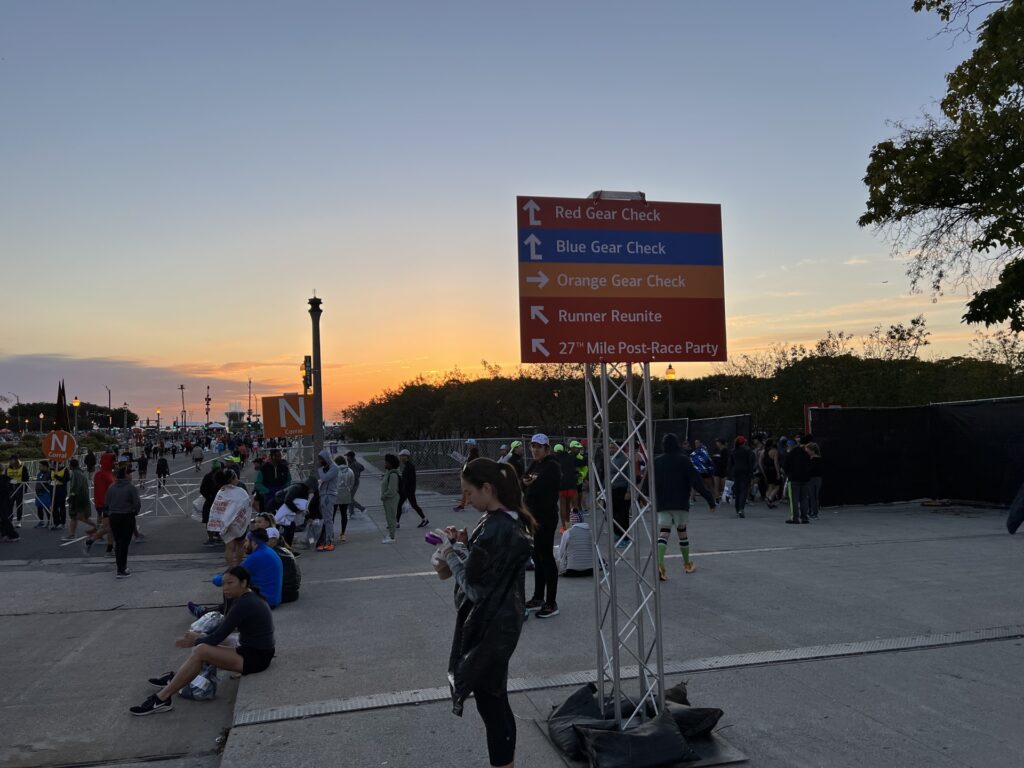
Pre-Race
I now had a cool hour and 15 minutes before my corral closed at 8:10. Good thing I was there 2 hours hour. Fortunately I had a friend who was running in my wave and was also there early. We were able to chat most of that time.
I also took a short lap around the starting area. There were cups of Gatorade and water available, a water filling station and medical services available. There were also lots of directional signs and tons of volunteers answering questions and steering people to their corrals.
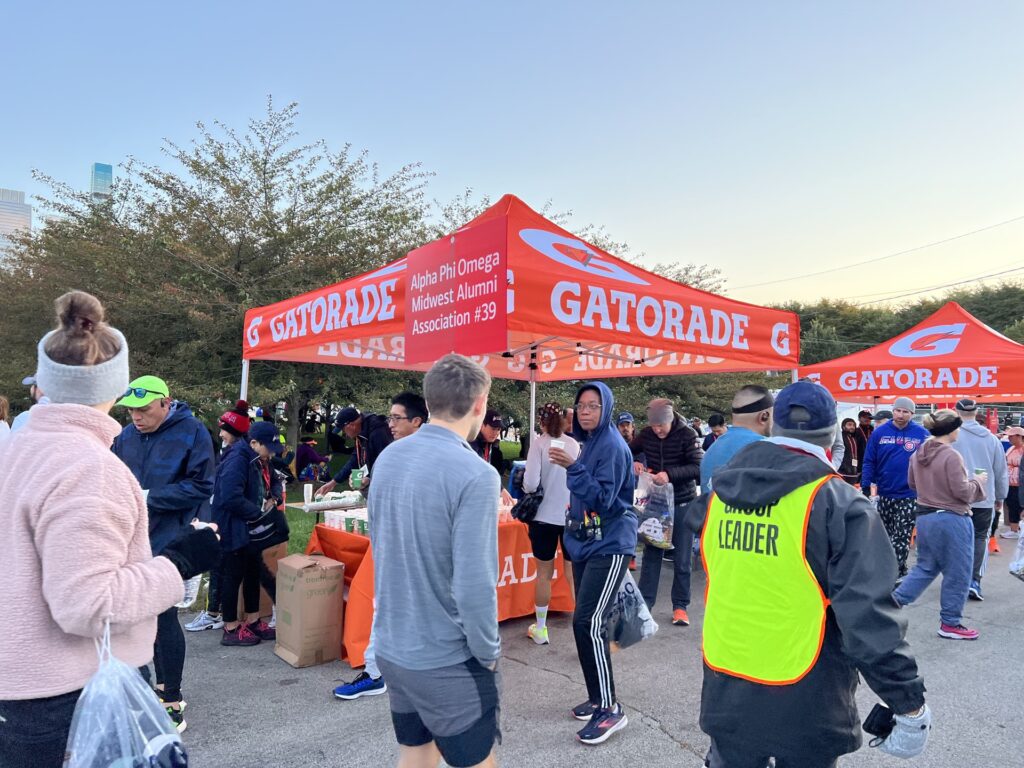
The start corrals are usually pretty energetic. There’s music blasting and a famed Chicago running announcer, Dave Kappas, keeps the crowd hyped.
However, I was really disappointed this year because there was no loud speaker near Corral N! I couldn’t hear any of the announcements or music from my corral, so it felt like we were just on our own waiting. This is honestly my biggest and only complaint about the 2022 Chicago Marathon.
Our corral closed and our wave at the scheduled time.
On the course
October 9, 2022 in Chicago was a perfect fall day, and Chicagoans love a fall day. Spectators were out in full force, pretty much from the moment I started at 8:35 AM till I finished around 2:30 PM. As a slower runner, a lot of times spectators loose energy or go home by the time I come around, but that was not the case.
The first half of Chicago Marathon had spectators almost the entire way. In fact, if I had a single complaint it was that there was too many spectators. At some places, spectators were closing in on the roads, leaving a more narrow path than usual. I’m not sure if there were fewer volunteers on the course managing the crowds or if there were just more people out. It didn’t create any major issues though and everyone could safely pass.
The aid stations along the course were well staffed and had plenty of supplies to keep me going. However, nothing gets me through the Chicago Marathon quite like the treats I pick up from spectators. There are people handing out everything from tissues to Jell-O shots.
This year I scored some Haribo gummies that gave me the push I needed at Mile 14. Candy does basically the same thing as energy gels to refuel, but tastes so much better. I also will always, always take a beer from someone in Pilsen. It’s my favorite mid-race boost! I just had a small cupful this year, but sometimes people hand out whole cans!
The later half of the course was tough. Longer stretches are through non-residential areas and it’s not as well connected by train, so it’s harder for spectators to get to. Charity Row, Pilsen and Chinatown are always key neighborhoods to look forward during this portion.
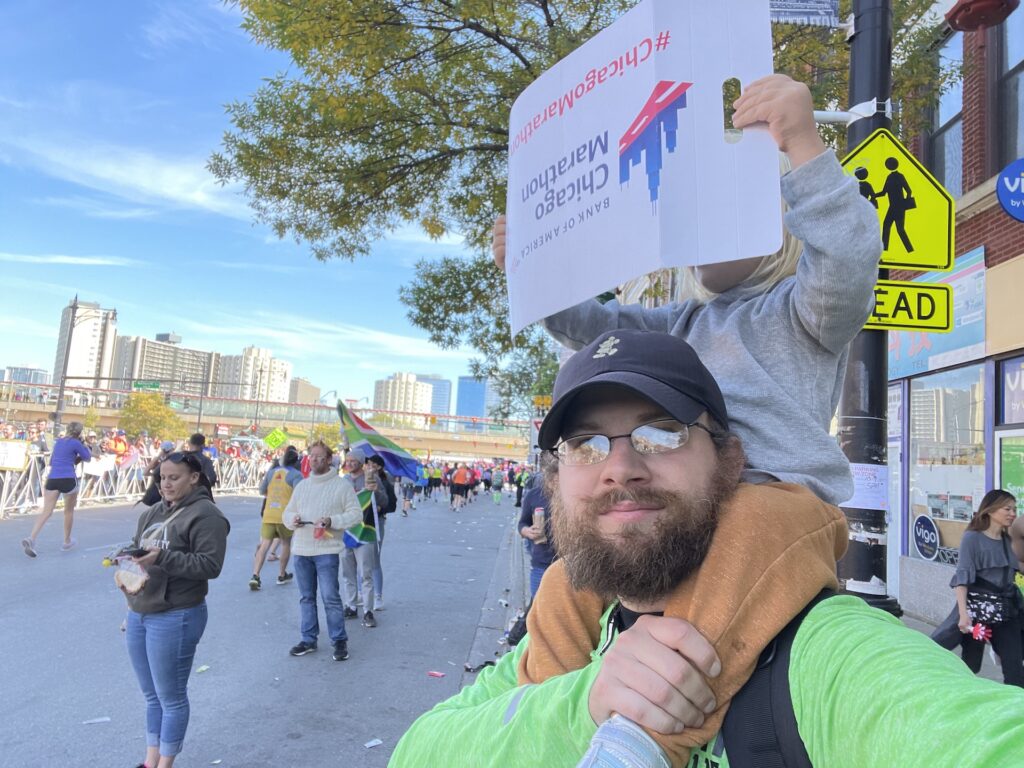
My favorite spectators were the highlight of my race
Spectators are lighter on the second half, but the people who are out in these stretches are fantastic. There’s always one or two people who stand out to me. This year, it was a man at mile 23. I was dragging. He looked at me and said, “You’re going to finish this thing!” I knew he was right.
The course changed a bit in 2022. Instead of running south along the highway, something I always dreaded, there’s now an out-and-back on Michigan Ave around miles 22-24. This was tough in a different way, because now I was passing runners on the other side of the street who were two miles further along. It was a really pretty segment though, and I preferred it to the highway.
The last two miles or so, coming up Michigan and heading toward the turn at Roosevelt are always something special. There’s crowds and music and signs counting down the meters to the finish. If you can make it to Michigan, you can make to that sweet, sweet finish line. And I did just that.
Finish Area
After the finish line, you have to walk a couple blocks to get out of the finisher area. It’s not short, but some races are definitely worse. You must keep walking forward during this area and cannot stop or sit. Medical support is available if you need assistance.
Then it’s time for your medal. Volunteers give each finisher their medal and they’re always so enthusiastic about it. I’m always thankful to the people who keep up their energy levels for slower runners, and the medal people do that.
Next up is snacks. This year, there were bananas, apples, bottled water, vegan beef jerky, Muscle Milk and, my personal favorite, beer!
Goose Island has a booth in the finisher shoot where you can get a special Chicago Marathon finisher beer. You don’t need to use year beer ticket, it’s just free and included. It’s truly the best and I look forward to it every year. After my first marathon, I was crying because I was so overwhelmed, and a girl at the Goose Island booth goes, “You look like you need this.” It’s been my most treasured finisher treat ever since.
At the end of the finisher shoot are directional signs to gear check, runner reunion spots, exits and the post-race party.

Gear-Check Retrieval
I headed first to gear-check to get my things. It was so fast that by the time I walked up to the booth, someone had my bag ready for me! This was surely extra fast because I was in the tail end of finishers, so the crowds were low and they had fewer bags left. But I was shocked at how fast and easy it was!
Post Race Party
There is a post-race party in Grant Park from 9:30 AM – 4 PM. There is live entertainment and every runner gets a ticket for a free Goose Island beer. Runners and guests are able to join the party.
I have honestly never been. I’m slow that by the time I finish around 2, I’m always ready to just go eat somewhere.
Chicago 2022 Overall Review
The 2022 Chicago Marathon was great. It was my second favorite Chicago Marathon, after 2018 when I set my current PR. Here’s how I’d rate some key metrics.
- Expo: 7/10
- Spectators: 9/10
- Volunteers: 10/10
- Weather Conditions: 9/10
- Course: 10/10
- Swag (medal, race shirt, official merch): 9/10
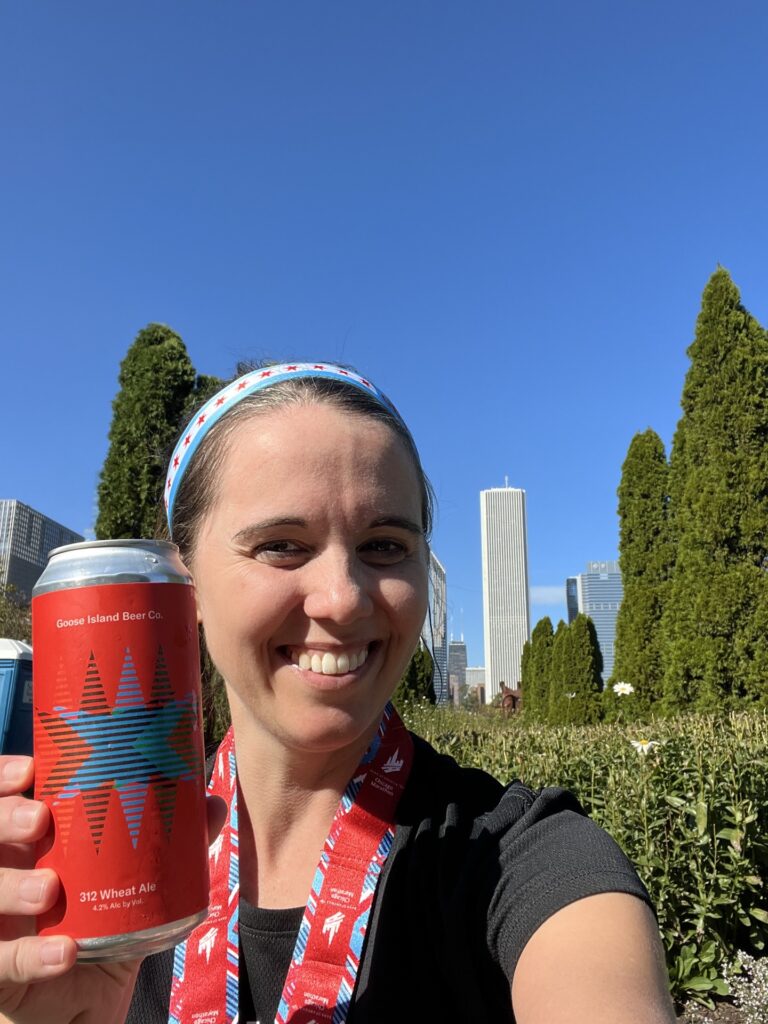
10 Tips for the Chicago Marathon
I’ve said a lot about the Chicago Marathon, but I simply cannot write this post without sharing some of my best Chicago Marathon tips! These are a few things I’ve learned about the Chicago Marathon over my six times running the race.
I’d love to hear your tips, too! I lived in Chicago for a while and am usually in the back of the pack, so I’m sure I have a lot of blind spots. If you have any tips that our readers should know, please share in the comments.
1. Take public transit.
Traffic downtown, especially on race day when streets are closed, can be chaotic. Parking is expensive and can be hard to find. The fastest and cheapest way to get to the Expo and the starting line is on public transportation, specifically the train.
You can tap-to-pay with any contactless credit card at the train turnstile or as you board any CTA bus.
2. Active spectators should get a 1-Day CTA pass.
If you have spectators who plan to hop around the course to cheer for you, encourage them to buy a 1-Day CTA pass. For $5, they can ride the train and bus as much as they want for 24 hours. Otherwise, each train ride costs $2.50, with up to two free transfers during a 2-hour time period.
You can buy a day pass from the kiosks inside any CTA train station.
3. Follow a training plan.
I watched a documentary about a guy who ran seven marathons on seven continents in seven days. When asked if he trained for it, he said something along the lines of, “Anyone can do it if you train.” In 2021, I ran the Chicago Marathon without training and that quote was the wind behind in my sails.
I’m sure I’m not the only one who has tried to run a marathon with zero training, but I can say I definitely don’t recommend it. Do some sort of training. There are plans out there that can accommodate runners of all speeds and abilities. Find one that works for you and stick to it.
My first year, I followed the Nike marathon training plan pretty religiously. Other runners swear by the Jeff Galloway run-walk method. In 2022, I followed a light training plan of my own design that alternated long runs every other weekend, building up to 18 miles. As long as you follow some sort of training plan, you can run the marathon.
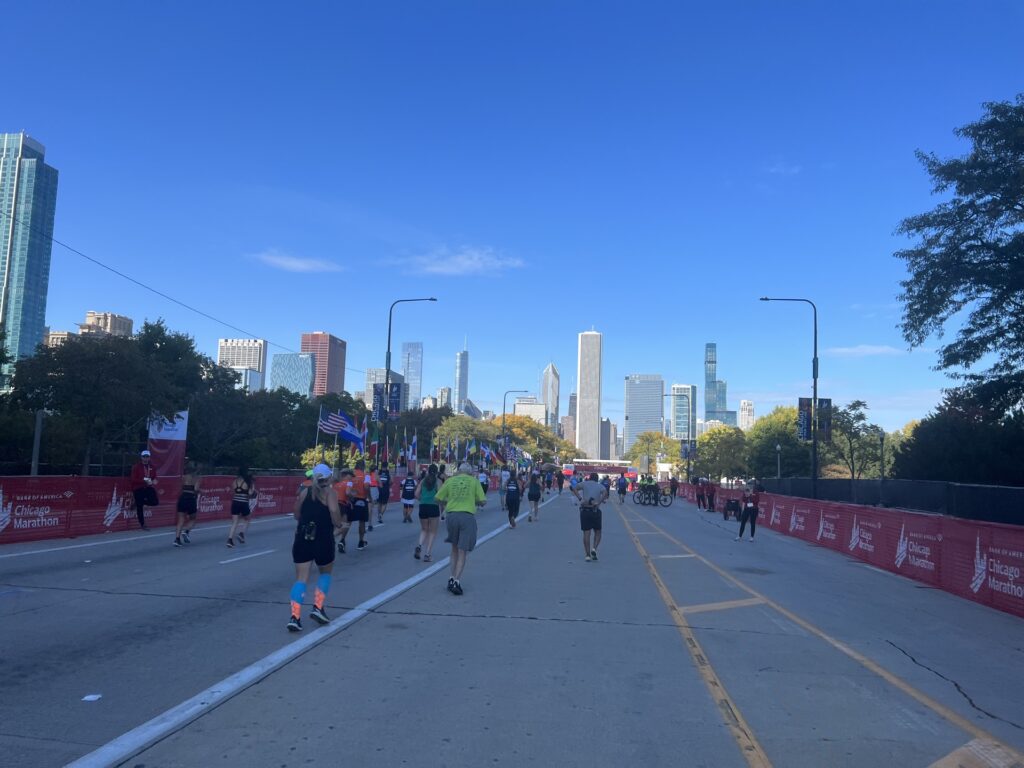
4. Take the Metra to the city from the Expo (and download the Ventra app!)
After the Chicago Marathon Expo, there’s a good chance you’ll want to head downtown to do some city things. Maybe to check out Cloud Gate (“the bean”) in Grant Park or for a stroll up Michigan to the Nike store for some finisher gear.
No matter your plans, if you’re heading toward the Loop, the Metra is the fastest and easiest way to get there, as long as you buy your tickets in the app.
The station is accessible from inside McCormick Place, and there are signs directing you there. The ME (Metra Electric) line then makes stops at Van Buren Street Station in the heart of Grant Park, and Millennium Station on the north end of Millennium Park.
If you take the Metra, be sure to download the Ventra app in advance. You can use the app to track train times and time your exit from the Expo. But most importantly, you can buy your Metra ticket in the app and avoid waiting in long lines at the kiosk.
5. Send spectators to the back half of the race.
The first half of the Chicago Marathon is the easiest to spectate. The course passes through similar areas multiple times and there are a lot more train stops to quickly get to a variety of view points. The back half is tougher to get to and as a result and the crowds are lighter. But that’s also when you need support the most.
If you can, try to get spectators to cheer for you somewhere along the back half of the race. One easy way for them to do that is to take the Red Line to Chinatown. They can watch you there around mile 21. Then have them walk east about half a mile and they can catch you on Michigan near mile 25. From there, they can walk a mile north to meet you at Grant Park after you exit the race area.
6. Check your corral as soon as it’s assigned and submit a change request if needed.
On my 2022 Chicago Marathon registration, I submitted an estimated finish time of 4:45. According to the 2022 qualifying standards, that would have put me in Corral K. However, when my corral was assigned, I was put in M. Starting in a later corral isn’t the worst thing, but I wanted to start as soon as possible.
I followed the steps provided in the email to request a corral change. My request was approved and I was moved to K. Corrals aren’t guaranteed and they can fill up, but it’s worth a shot. If you feel like your corral is wrong or your estimated finish time changed, be sure to submit a change request during the window.
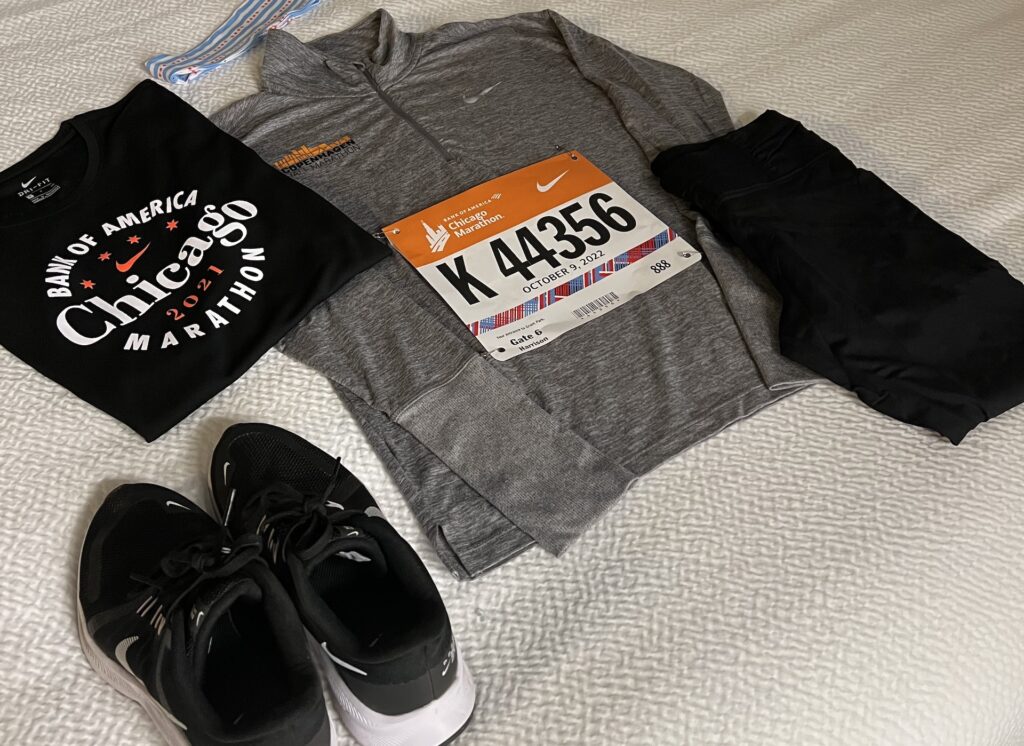
7. Stop by the Nike store on Michigan Ave.
The Nike store on Michigan Ave sells the full line of Chicago Marathon apparel, including everything that’s available at the Expo (while supplies last). More importantly, the Nike Store on Michigan Ave is the only place where you can find finisher gear. It’s usually only available on Saturday and Sunday of race weekend, but in 2022 it was released early on Friday.
The lines are usually longer at the Nike store than at the Expo, but it’s got a fun energy.
Also keep in mind that the Nike store accepts returns on Chicago Marathon apparel. If you buy too much at the Expo or if you find a finisher shirt you like better, you can return unwanted items at the store.
8. Book your hotel in advance and check in early.
Hotels in Chicago over marathon weekend sell out quickly and can be very pricy. Be sure to book as soon as possible to get the best deal and the best location.
Booking is only half the battle, though. Be sure to check in to your hotel as soon as you can. I had a really bad experience in 2022. My hotel was oversold and they had no room for me, even though I had a reservation. They had to send me to a different hotel two miles away at 8 PM the night before the marathon. Checking in earlier could have prevented this problem.
Having status at your hotel chain also helps. They told me that they do not move people who have status with the hotel. Unfortunately, our platinum status was under my husband’s name and he wasn’t with me, so that didn’t help me this time.
9. Train with what’s on the course.
This tip is not particularly profound, but helpful none the less.
You never want to do anything different on race day. If you train with a certain type of fuel, you should use that same fuel on race day. Since the Chicago Marathon has Gatorade Endurance on the course, it’s a good idea to train with that, too. That way you don’t have to carry around any special fuel with you on race day.
When I started training for marathons, it was in Chicago on the Lakefront Trail. There is regular access to water and on Saturdays, the local running group provides free Gatorade at a few different points. Because of that, I never had to carry any fuel or drinks with me. I no longer live in Chicago, but I continue to train with what’s on the course to keep things simple.
10. Enjoy the race!
Running a marathon is hard. When race day comes, sometimes you have it and sometimes you don’t. Sometimes that pick-me-up song will hit at just the right time and will power you to a PR. Other times your IT band will seize at mile 17 and every step will make you want to cry. No matter how much you train or how prepared you are, race day can surprise you.
So my wish for you is that you find a way to enjoy the race for whatever it is for you. I hope you see a sign that makes you laugh so hard you pee a little. I hope someone cheers for you by name when you need it most. Tap every power up sign and high-five every toddler. Drink the beer in Pilsen and try to honor each charity you see on Charity row. Take out your headphones when you run that last mile down Michigan and turn onto Roosevelt. Soak it all in.
Regardless of your time or how many marathons you’ve run before, I hope you cross the finish line and are consumed with an overwhelming sense of accomplishment. The Chicago Marathon is special to me, and I hope you feel that, too.


Ashlee
Wednesday 7th of June 2023
Thank you so much for this guide - I loved reading it. I will be coming for New York - traveling with a 3.5 year old and a wife. I am nervous about them coming and how my toddler will react to such a long race. Trying to find things for them to easily do AND see me on the course. Did your toddler do this too?
Emily
Thursday 8th of June 2023
Hi! I'm glad you found us! We will actually be making the same trip from New York to Chicago with our 3 year old. This year my husband will be running and d last year I ran. So we've thought through your exact scenario. Sorry in advance that this is really long. :)
Before the race, you'll probably want to take things easy. We started by bringing our toddler to the expo, which they enjoyed. There was lots of free samples, fun photo ops, they can make a sign, things like that. Plus the rest of McCormick place has fun fountains and escalators and lots of snack options, which my 2yo enjoyed. I'd recommend going early on Friday if you can. Saturday morning was really busy, but lightened up in the afternoon. After that, we took the train downtown, got donuts at Stan's Donuts (call it carb loading?), saw the bean (which my toddler LOVED), walked down the lake front trail (great views), and ended at Lincoln Park Zoo (free to visit, but they have a carousel for a few bucks).
During the race, how much they get to do will depend a bit on how fast you are. I was running at a 5 hour pace, so they got to see me several times. Here's how we spectated last year with a 2yo.
1) Mile 1.5ish at State & Lake — They took the red line to the Lake stop. This was a quick stop so they just played on a sidewalk. 2) Mile 3ish at LaSalle & Lake - They walked over to LaSalle to catch the return, which didn't require crossing the course. They only had a few mins before I arrived, so just watched for me and got their sign ready. 3) Mile 8 at Sheridan & Broadway - They took the red line from Lake up to the Sheridan stop and just barely caught me at 8. Anyone running much faster, this would have been tight. From the Sheridan stop, it's just a short walk to the course. 4) Mile 11 at Sedgewick & North Ave - They took the red line from Sheridan to Fullerton and switched to the brown line to Sedgewick. Here they met with some of our friends, and went out to lunch. There's a couple of pub restaurants on the east side sedgewick, and south side of north, so you won't have to cross the course. Or pack a lunch. The energy around here is high and there's live bands, which should hopefully enertain a little one. 5) Mile 21.5 ish in Chinatown - After lunch, they took the brown line to Harold Washington Library and switched to the red line to Cermack-Chinatown. Chinatown is really fun for spectating! There's lots of people, people are playing drums, there's the big gate. Plus if you walk down the east side of Wentworth, there are a few Chinese bakeries and bubble tea places. 6) Mile 25 on Michigan Ave - They walked straight west from Chinatown to Michigan Ave, where they caught me at mile 25. Then they just walked the last mile up Michigan to meet me after the race near Roosevelt. That comes out to a 1.5 mile walk, so you could also hop on the red line in Chinatown and take that to Roosevelt and catch mile 26.
As you can tell, it was a lot of running around, but it kept them busy all morning. Our little one really like trains, so that was fun, and they loved finding me in the crowd of runners each time. My husband had a blast with them and i'm looking forward to spectating with our kiddo this year!
Good luck!!
Danny
Wednesday 26th of April 2023
Great info! Thanks. Am I correct to assume that the CTA runs trains more frequently and earlier on Marathon day?
Emily
Friday 28th of April 2023
You are correct! Trains run earlier and more frequently, and/or they actually use longer trains to accommodate more people. I just ran the London Marathon and had an awwwwful experience on their train to the race start (we were delayed 30+ minutes) and I'm happy to say that has never happened to me in Chicago.